He rau ringa e oti ai
Collaboration lifts achievement, engagement and wellbeing
How West Coast kāhui ako is forging a stronger future

Meeting the needs of remote rural areas in Central King Country
A living, breathing community classroom in Queenstown
6 JUNE 2023 | VOL. 102 | NO. 7
Creatives in Schools opens 16 June
The Creatives in Schools programme provides funding of up to $17,000 per project.
Kura and schools will work with their partner artist to plan and run their project. This can be any type of artform such as visual, performance, design, digital arts, Pacific arts and ngā toi Māori.
If your kura or school is planning to run a creative project for your ākonga in 2024, apply for Creatives in Schools.
Register for information webinar:
The Ministry of Education and Tātai Aho Rau Core Education will hold a webinar on Wednesday 21 June 3:30-4:30pm to help walk you through the application process.
Principals, kaiako and their creative partners are invited to attend.
Visit our website to register: creativesinschools.tki.org.nz
For questions, email: CreativesinSchools@education.govt.nz


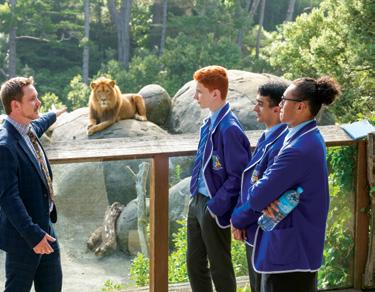
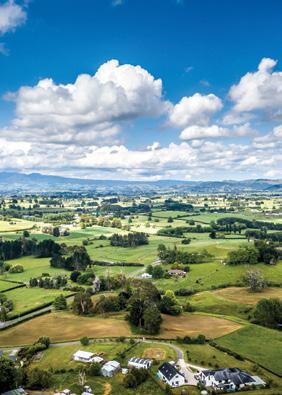




1 Tukutuku Kōrero 4 How West Coast kāhui ako is forging a stronger future 12 Making science fun and accessible 16 Tauira to Tumuaki: Te Iri Rangi Tawhara shares journey to leadership 20 Meeting the needs of remote rural areas to lift attendance 24 A living, breathing community classroom in Queenstown 28 Empowering a generation of ‘Girl Bosses’ in healthcare, science and sport 36 Setting ākonga up as true innovators in business and beyond 40 Ākonga step ahead with stronger problem-solving skills 46 Youth programme puts learners at the centre of the community – and its future 50 Bringing joy back to teaching and learning post-Covid 54 Te Rito gets a sector-led restart On the cover Page 4. In the West Coast region, Māwhera Kāhui Ako arotahi groups work collaboratively to address attendance and improve transitions between education settings. ISSUE 102.7
4 16 12 20 24 28 6 June 2023
Contents
Get this in your inbox! Education Gazette Publication dates
Read each new edition before it’s in print by subscribing to the Tukutuku Kōrero | Education Gazette newsletter. You will get the latest content straight to your inbox, including bonus online articles, videos and podcasts.
To view the PLD, general notice listings and vacancies at gazette.education.govt.nz
Scan the QR codes with the camera on your device.
SUBSCRIPTIONS
to advertisers agreeing to NZME. Educational Media’s terms and conditions www.advertising.nzme.co.nz/ terms-conditions-credit-criteria DEADLINES
The deadline for display advertising to be printed in the 26 June 2023 edition of Education Gazette is 4pm on Friday 9 June 2023.
VACANCIES NOTICES PLD
2 Education Gazette gazette.education.govt.nz This publication is produced using FSC® Certified paper from Responsible Sources.
IDEAS We welcome your story
email
STORY
ideas. Please
a brief (50-100 words) outline to: gazette@education.govt.nz
KEY CONTACTS Reporter gazette@education.govt.nz Display & paid advertising Jill Parker 027 212 9277 jill.parker@nzme.co.nz Vacancies & notices listings Eleni Hilder 04
9796 vacancies@edgazette.govt.nz notices@edgazette.govt.nz PUBLISHED BY Education Gazette is published for the Ministry of Education by NZME. Educational Media Ltd. PO Box 200, Wellington. ISSN 2815-8415 (Print) ISSN 2815-8423 (Online) All advertising is subject
eleni.hilder@nzme.co.nz VIEW US ONLINE Web: gazette.education.govt.nz Instagram: @edgazettenz Youtube: youtube.com/ edgazettenewzealand
915
EDITORIAL ADVERTISING
VACANCY BOOKING AND ALL
DEADLINE BY
PUBLICATION
102.8 9 June 14 June 26 June 2023 TERM 3 EDITORIAL ADVERTISING BOOKING DEADLINE VACANCY BOOKING AND ALL ARTWORK DEADLINE BY 4PM PUBLICATION DATE 102.9 30 June 5 July 17 July 102.10 21 July 26 July 7 August 102.11 11 August 16 August 28 August 102.12 1 September 6 September 18 September
2023 TERM 2
BOOKING DEADLINE
ARTWORK
4PM
DATE
Many hands make light work
There is nothing light about the mahi it takes to get ākonga attending school or kura and engaging with their learning. But if the stories we keep sharing in Tukutuku Kōrero are anything to go by, you are all collectively putting your hands up, and going above and beyond to meet the ever-evolving challenge. And that’s where the light lies. Doing the mahi together. Collaborating to lift the achievement, engagement, and wellbeing of ALL ākonga, and their families.
In the West Coast, one kāhui ako is planning for the wellbeing and success of ākonga throughout their entire education journey, from early learning through schooling and beyond. Schools are working collaboratively with early learning kaiako to improve transitions, and partnership with iwi and associate members/agencies support the bigger picture – a thriving region that knows its histories, are skilled and qualified, and achieving their aspirations.
Also rising to meet the needs and aspirations of ākonga in remote, rural areas is Te Manu Kōrero O Ngā Mātauranga – Central King Country Rural Education Activities Programmes. Their attendance service works collaboratively with schools and other agencies to lower barriers, such as access to period products,
uniforms, healthy lunches, school supplies, learning resources and importantly – community support.
Down in Central Otago, a youth programme is successfully re-engaging ākonga in learning opportunities and career pathways. The article talks about the idea of “having a village to raise a child” and how schools can collaborate with whānau and employers to secure the future of ākonga, and the region.
Collaborative efforts to empower generations of young New Zealanders is certainly at the fore of almost every article in this issue; whether it’s as innovators and business leaders, as young conservationists and scientists, as the future movers and shakers in education, or as mana wāhine making a difference in healthcare, science and sport.
He rau ringa e oti ai. Many hands make light work.
Ngā manaakitanga
Sarah Wilson
Ētita | Editor

NOTE 3 Tukutuku Kōrero 6 June 2023 APPLICATIONS FOR STUDY IN 2024 OPEN 1 JUNE 2023 AND CLOSE 1 SEPTEMBER 2023 keystonetrustNZ @keystonetrustnz
EDITOR’S
KĀHUI AKO

How West Coast kāhui ako is forging a stronger future
Māwhera Kāhui Ako is going from strength to strength as it plans for the education and success of ākonga from early learning through schooling and beyond – some of its success lies in its inclusion of, and collaboration with, early learning services and iwi, and its focus on transitions and wellbeing.
4 Education Gazette gazette.education.govt.nz
The Transition to School Arotahi Group who share a common goal of smoothly transitioning tamariki from early learning to school.
The Māwhera Kāhui Ako covers the Grey District and in just a few years has grown to include five early learning services, 13 schools and nine associate members, which include Ngāti Waewae and Te Tai Poutini West Coast Regional Skills Leadership Group (RSLG).
Mandy Dodds, principal of Kumara School, and Shirley Serban, principal of Lake Brunner School, are the kāhui ako leads.
In 2021, they called an after-school teachers’ meeting to talk about what was needed for the children and youth of the area – and were amazed at the turnout.
“About 120 people arrived. That was quite exciting because we went into that meeting expecting very little and got just about every school rep and some early learning people in our area,” says Mandy.
“We both took on leadership roles with the kāhui ako because we felt it had the potential to be something powerful. Both of our own schools don’t necessarily have the same needs as other schools in the kāhui ako – we’re both small, rural schools – but while this resource exists, let’s tap into it for the good of all,” explains Shirley.
“We work very hard to change the mentality from ‘what does my school get out of it?’ to ‘what do the students of the region get out of it?’” she adds.
Shared data
The pair looked at shared kāhui ako wellbeing, attendance and academic data and while they had a few hunches about key issues, they took the data to the principals’ group, and then the 2021 meeting.
“We shared the data, along with a little about what we were thinking, and then we got them to brainstorm and write down what they thought we needed, how we should go about it, where we should go and what everybody’s needs were. Out of that, Shirley and I developed a new strategic plan,” explains Mandy.
The data identified four key areas along with the strategic plan (which is currently being reviewed and refreshed), and the acronym WEST was developed: Wellbeing, Engagement, Success for all and Transition. The plan was aligned with NELP (National Education and Learning Priorities) and the education plan of Ngāti Waewae.
Transition to primary school Arotahi groups were set up to focus on the key issues of attendance and transitions between education settings. Two arotahi groups are going strong – early learning to primary school, and primary school to secondary school.
“We’ve let them continue organically where there’s momentum, but the idea is that it’s not made up of leaders saying, ‘Here’s a group, do this work.’ It’s a way to empower the in-school teachers as well to develop their leadership.
“Teachers who are interested in the topic meet quite informally twice a term. And before they come up with any answers, they define what the problem is,” explains Shirley.
Brenda Tomkinson, deputy principal at Grey Main School, teaches new entrants and is an across-school teacher for the kāhui ako. She came to the West Coast as a beginning teacher in 2001 and has taught most year groups at Grey Main School since then, but her particular passion lies in the transition to school.
“That arotahi group is just going from strength to strength and that has come from including those early learning services within the kāhui ako – we each have a common goal of what we want to achieve,” she says.
Early learning teachers and new entrant teachers meet once a term, and while the meeting is just an hour long, teachers can share information and build relationships.
Meetings are held at 5pm, rather than straight after school, which means that early learning teachers feel welcome and can attend.
“At the moment it is about smoothing those transitions. A big thing for us is developing a pamphlet that goes out to our early learning parents about preparing children for school. What’s cool is it has a voice from both the early learning services and the schools,” explains Brenda.
Transition to secondary school
Data showed that boys from small rural schools weren’t having issues when they went to secondary school, but girls were struggling.
“We put it down to the fact that our girls are full of confidence when they leave here – they’re leaders,” explains Mandy.
“We work very hard to change the mentality from ‘what does my school get out of it?’ to ‘what do the students of the region get out of it?’”
Shirley Serban
5 Tukutuku Kōrero 6 June 2023
“Unfortunately transitions and identity are all mixed in the same pot when you’re going from being a big cheese in a small school to a tiny cheese in a big school. Their roles seemed to be reversed – they became non-achievers at secondary school. It surprised us,” adds Shirley.
Amanda Bailey is deputy principal of Awahono School in the Grey Valley and leads the Primary to Secondary School Arotahi Group. To address the large leap that rural school children may experience when they go to secondary school in Greymouth, an annual transition day was implemented in term 3.
“We interviewed the children and asked them what they are worried about when they transition to secondary school. The secondary schools sent along a variety of children – including those who found primary school challenging but have had the chance to shine in other areas at secondary school,” says Amanda.
“Our children are very sheltered. Some of them come from a setting where there are literally eight other children of their year level and suddenly, they’re going to be chucked into a setting where there could be 90 or 100 children in their age group. We want to break it down, so they have connections when they go on that first day.”
Restorative practice
Through their wellbeing data, the kāhui ako identified areas to work on and sought funding for regional professional learning development.
“We took on restorative practice because our wellbeing survey was telling us that in some ways things were going well and although the children knew what to do, they weren’t always putting it into practice,” says Mandy.
“A lot of the feedback was ‘my teacher doesn’t care about me as a person, or my culture, or what I bring to
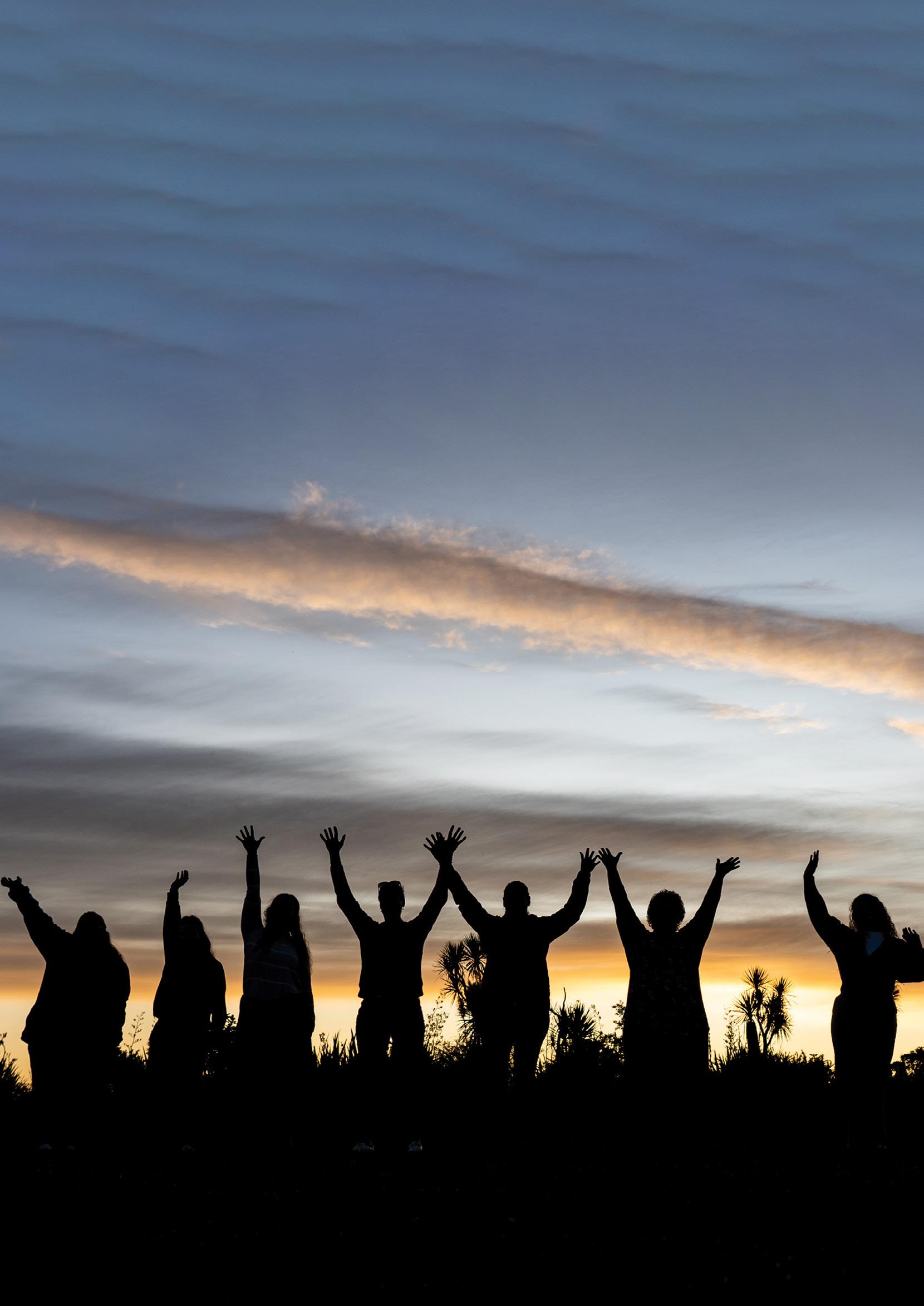
the table’. Most teachers will say ‘that’s not true’. However, it’s student perception – that’s how they feel, so we have to address it,” says Shirley.
“One of the things we have noticed with the wellbeing data, is there are always going to be areas to work on but considering what our communities and schools have been through over the past couple of years, the fact that it’s stayed very similar is a huge win.
“We’ve had this tumultuous couple of years and we’re not seeing the stress rising,” she adds.
Relationships and collaboration
Anecdotally, stronger relationships and better communication are already making a difference.
“We’ve still got areas to work on, but I think schools are becoming more aligned because of the kāhui ako. For example, we’re seeing people not afraid to take on structured literacy because they can pick up the phone and say, ‘I’ve got a release day, I met you at a kāhui ako, could I come into your classroom to observe?’” says Amanda.
“If we weren’t a part of the kāhui ako, those of us in smaller schools just couldn’t have that PLD which links back to raising achievement. What it also means for our children is that they hear the same language at every school they go to in the kāhui ako,” she adds.
Brenda has just started her third year with the kāhui ako and says the arotahi groups are breaking down barriers.
“My biggest achievement has been the relationships I have built up so people can feel they can share and contribute. For me [as an across-school teacher], it’s being able to go into the secondary schools, down to the Trades Academy and into early learning services, knowing that I feel really welcome and that they understand why I am there.”
Mahi tahi – Working together for young people on the West Coast.
“We took on restorative practice because our wellbeing survey was telling us that in some ways things were going well and although the children knew what to do, they weren’t always putting it into practice.”
Mandy Dodds


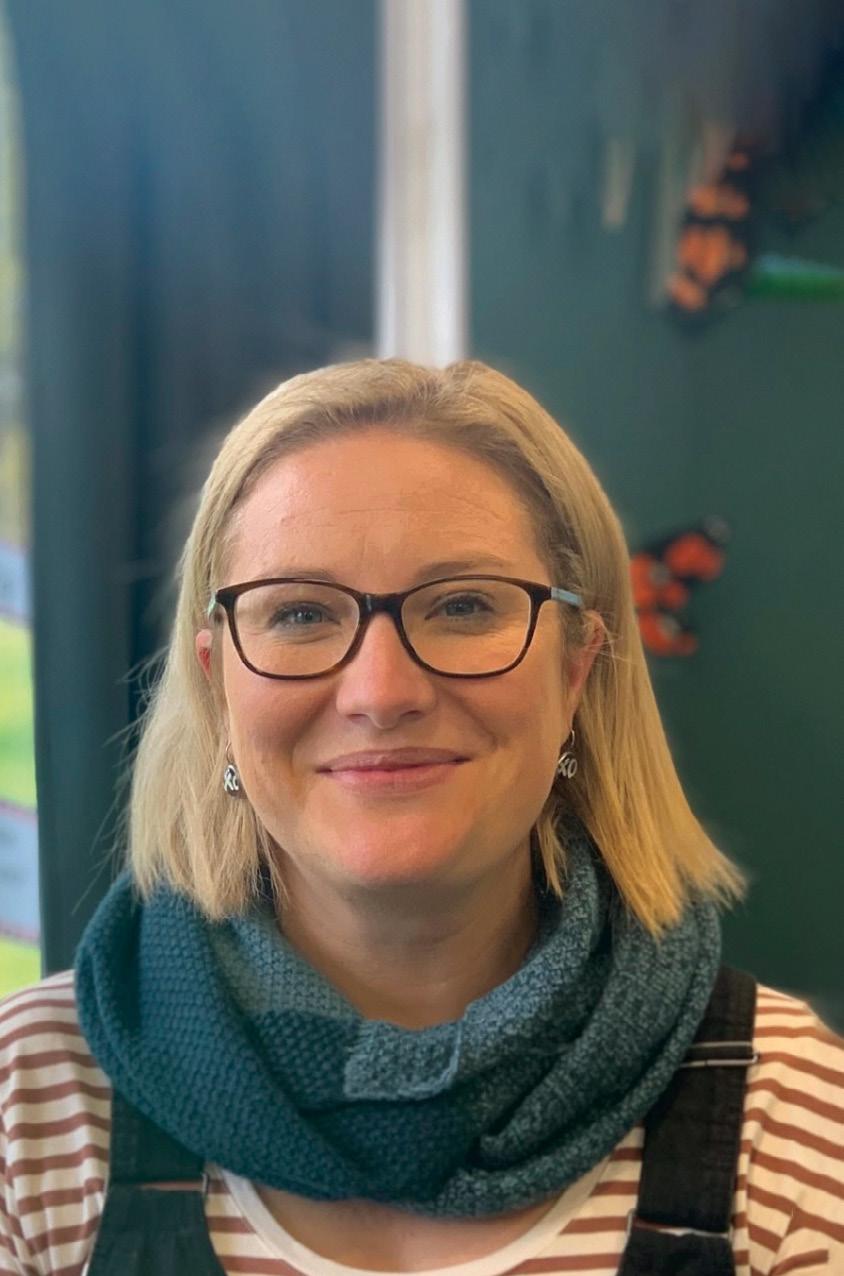 Above: Brenda Tomkinson. Below: Amanda Bailey.
Above: Brenda Tomkinson. Below: Amanda Bailey.


8 Education Gazette gazette.education.govt.nz
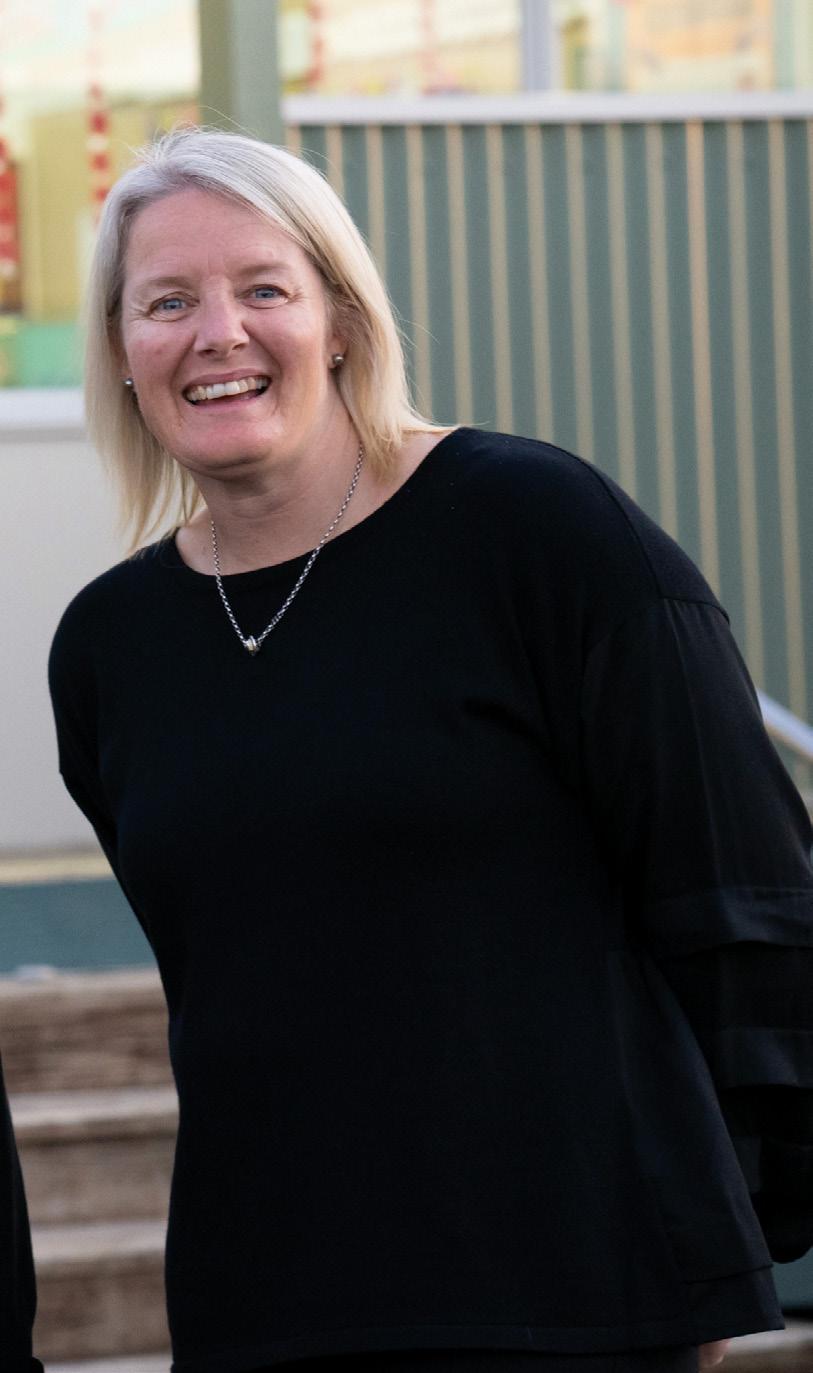
Partnerships
A recent kāhui ako teacher-only day about the refresh of The New Zealand Curriculum saw a couple of hundred teachers gaining an overview of the changes.
“It still amazes me that people will turn up because we’ve asked them to,” laughs Mandy.
“For things like the refresh, the kāhui ako days work well – we get an overall picture. Even with the restorative practice, it’s big picture stuff and making connections and talking to each other.
“The next Accord Teacher Only Day will be in term 4 – we won’t do that as a kāhui ako because everybody now needs to put their own flavour on it and make it fit their school. We certainly don’t want everybody doing exactly the same thing, because we’re not carbon copies of each other,” explains Mandy.
The kāhui ako has received funding to engage with Ngāti Waewae to build better relationships and resourcing to help students understand the world view of Mana Whenua.
“That’s been going really well. Through that, all staff in the kāhui ako have been connected to the Ngāti Waewae website – we’ve got PLD through that,” says Mandy.
The iwi has developed picture books for their whānau on subjects such as their own narrative about pounamu.
“We can provide some funding as the books are being developed and that will benefit our staff because we have Ngāti Waewae students in our schools and we want to support their aims as much as we can. When we do our strategic plan, we try to align as much as we can with their aspirations,” says Shirley.

9 Tukutuku Kōrero 6 June 2023
Left: Shirley, Mandy and Brenda share a passion for collaborative leadership –and the youth of their region.
Below: A recent Transition to School Arotahi Group hui was held with educators from early learning services and primary schools at Paroa School.
The big picture
Big picture thinking has attracted associate members to the kāhui ako who share the same goal to help West Coast tamariki and rangatahi succeed.
Te Tai Poutini West Coast Regional Skills Leadership Group (RSLG) is one of 15 established by government to identify and support better ways of meeting future skills and workforce needs.
“When our children leave school and tertiary training, we want to ensure they have the basic skills and qualifications needed to secure jobs and build careers,” says Graeme Neylon, co-chair Te Tai Poutini West Coast RSLG.
The RSLG approached the Māwhera Kāhui Ako to learn more about their vision and strategic plan, discuss alignment with the Regional Workforce Plan, invite them to participate in Workforce Plan workgroups and seek input into RSLG advice to the Tertiary Education Commission.
“We have the same purpose. If we can see that next generation of children now in early learning finish secondary school, some of the mahi we’re doing now is going to result in better wellbeing, engagement, smoother transitions and everyone having a chance for success in their own space as children of Māwhera,” concludes Shirley.
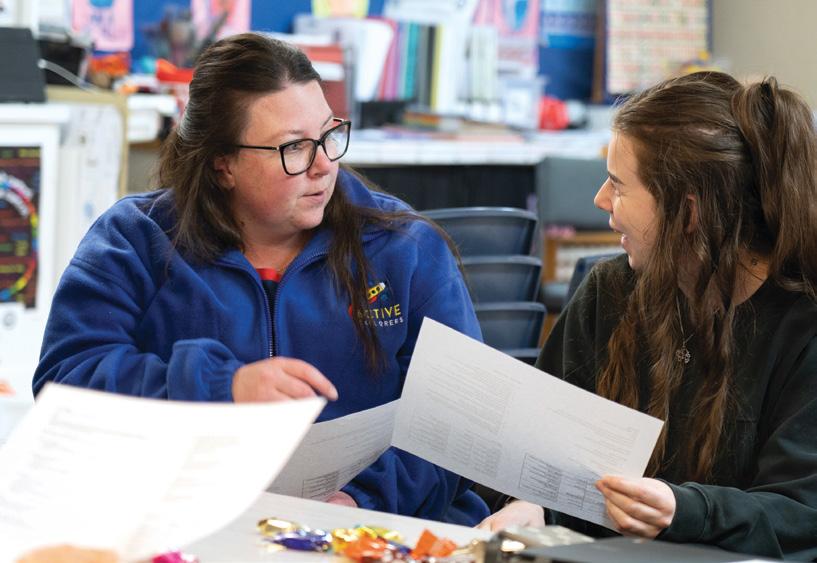


Read more about collaboration on the West Coast in Education Gazette Volume 101, issue 15.

10 Education Gazette gazette.education.govt.nz
A recent Transition to School hui focused on a pamphlet for whānau. Above: Stacey and Alysha from Active Explorers, Nelson Street discuss the mahi.
The Transition to School Arotahi Group with across-school teachers, within-school teachers, early learning educators and primary school teachers all share common goals.


Making science fun and accessible
This year’s winner of the Prime Minister’s Te Puiaki Kaiwhakaako Pūtaiao Science Teacher prize, Doug Walker, has a passion for making science more accessible and appealing – at a school, regional and national level.
Doug Walker’s passion for science is obvious – it’s an electric enthusiasm he has passed onto his students at St Patrick’s College in Wellington. But he gives credit to a team effort from other talented science teachers and key partnerships for the success.
As head of science at St Patrick’s for the past 11 years, Doug’s work connecting science teachers in Wellington has led him to the role of president of the New Zealand Association of Science Educators, which provides professional development to science teachers.
His achievements include introducing a senior science programme that enables more students to achieve University Entrance and bolstering science resources at his school, and developing and sharing science learnings widely online.
Accessibility
Doug says utilising technology, building relationships and making learning fun are the keys to involving and advancing students in science.
When he noticed that many lower achieving students at his school were dropping science from Year 11, he introduced new general science subjects and a pathway to study and gain University Entrance (UE) science.
The number of senior students taking science has increased 60 percent since the initiative in 2017, with more students achieving UE each year since.
With his team, he increased assessment opportunities and methods in science, and expanded the tools available for practical learning through DIY endeavours and grants.
“There were a lot of students who were in school for rugby, and they needed a slot to fill in their timetable.

Getting out of the classroom to see science at work has been a key way for Doug to motivate students, such as trips to Wellington Zoo.
SCIENCE
They were just happy to get any credits at the Achieved level,” says Doug.
“As time went on, some students actually got a Merit, and you could see the aspirations within the room building.”
In 2022, Doug asked his students what they wanted from science. All of them replied, they wanted University Entrance. They didn’t all get it, but Doug says just the shift in their attitude was incredible.
Around the time of Covid-19 lockdowns, the schools started experimenting with Zoom lessons but found that a webinar platform was more suitable. There was less external noise and students could contribute by typing in. It was then extended on a national scale.
Suddenly, with a national pool of teachers, they could offer help with more NCEA subjects, and any students could opt in. The videos were seen by thousands of students, with views during the pre-exam period growing from 24,000 in 2021 to 60,000 in 2022.
The concept worked so well that the Ministry of Education took up the idea with StudyIt – a forum where students get help with exam questions and teachers are paid to help.
Doug’s online presence goes beyond that too. Over the past 10 years, he has shared 34 NCEA science videos on a YouTube channel, amassing 1400 subscribers and 157,000 views.
“It becomes very easy to show somebody else without having to repeat the individual steps and you are not limited to just sharing the work face to face.”
Doug also presents at science education seminars and conferences in Aotearoa and overseas, and, with colleague Andrew Sargent, produced 30 videos of innovative practical science ideas for the New Zealand Institute of Physics in 2022.
Stimulating interest
Motivation is one of Doug’s key goals. He says research is important to create good lessons, and these are then spiced up with interaction and competition.
“Looking at the research and finding ways to try and get students to engage with the learning. So, you don’t want students just sitting there listening, you don’t want them just working through a workbook, you want to bring science to life for them, so hands-on, fun, engaging activities are really important.”
He adds that building good resources that enrich teaching and learning, and collaborating with local partners like Wellington Zoo, Carter Observatory, NIWA and Te Papa in the community enhances learning experiences for students.
“The world around us is fascinating and I enjoy sharing that with others. I get much joy from the students’ enthusiasm – that’s when you know you are making a difference,” says Doug.
“You don’t want students just sitting there listening, you don’t want them just working through a workbook, you want to bring science to life for them.”
Doug Walker


13 Tukutuku Kōrero
6 June 2023

 Doug says the experiences and conversations that happen outside the classroom are “absolute gold”.
Doug creates hands-on, fun and engaging activities for students at St Patrick’s College.
Doug says the experiences and conversations that happen outside the classroom are “absolute gold”.
Doug creates hands-on, fun and engaging activities for students at St Patrick’s College.
“If you actually go out and see something in the real world, it opens up your mind to how things fit together or to possibilities that you wouldn’t experience while you were in the classroom.
“And sure, we can put posters up on the wall and that’s all very nice and has connections, but the conversations that happen and the experiences that happen outside the classroom are absolute gold.”
Value of competition
Doug also believes in the value of competition to motivate and engage students. This concept of competition can help shape classroom activities.
This could mean the ‘walk the plank’ activity, where a railway sleeper is balanced on a desk. Students have to make accurate calculations, or they are likely to fall off. Another example could be ‘jeopardy’, where the students could even write the questions themselves.
Competition can also be worked in with good scientific practice, such as hypothesizing but then voting on the most likely outcome. An example would be applying a vacuum pump to a jar of marshmallows and predicting what might happen.
“This idea of competition, they really thrive off that. I know that research has two different schools of thought on it, but in my experience, I find it can be a hugely motivating factor.”
Some students don’t want to be wrong so don’t want to engage, he says, but it is worthwhile encouraging them.
“There’s nothing to fear about being wrong, it’s all part of the process. I get things wrong sometimes as well.
“If we can get them to a stage where they vote, they’re already engaged and are thinking slightly differently than somebody who sits back and says, ‘I’m just going to wait and see what everybody else says’.”
Perseverance
Going through high school in Scotland, Doug says he struggled with many subjects, and that science was one he could understand, although physics was challenging.
He later achieved a Bachelor of Sciences and completed his teaching qualification at Cambridge University followed
by a Masters in Education. Two years of teaching followed in England before he emigrated to Aotearoa.
Starting out as a biology teacher, he overcame his aversion to physics when offered the opportunity to study and teach the subject. “I am a biology teacher by degree but a physics teacher by demand and one of a growing number of non-specialist physics teachers.”
Doug encourages students to persevere with science, which has a role in teaching young people how to recognise reliable information.
“It is important to learn the ability to separate fact from fiction and understand how to make sense of the information we get in the modern world.”
Recognising teaching excellence
Te Puiaki Kaiwhakaako Pūtaiao Science Teacher Prize is awarded to a registered kaiako who has been teaching science, mathematics, technology, pūtaiao, hangarau or pāngarau learning areas to school-age children in a primary, intermediate or secondary New Zealand registered school or kura kaupapa Māori.
This is one of five prizes awarded each year.
The Government introduced The Prime Minister’s Science Prizes in 2009 as a way of raising the profile and prestige of science, in Aotearoa and internationally.
For more information on how to apply, visit pmscienceprizes.org.nz.
“This idea of competition, they really thrive off that. I know that research has two different schools of thought on it, but in my experience, I find it can be a hugely motivating factor.”
Doug Walker

15 Tukutuku Kōrero 6 June 2023

Tauira to Tumuaki
Te Iri Rangi Tawhara shares journey to leadership at Te Rangi Āniwaniwa
Te Iri Rangi Tawhara has spent much of her life at Te Rangi Āniwaniwa – a kura kaupapa Māori located between Kaitaia and Awanui. She started at the kura as a student in 1997, and 20 years later became Tumuaki.
16
LEADERSHIP
Te Rangi Āniwaniwa Tumuaki Te Iri Rangi Tawhara with her son, Te Pua Tawhiwhi, and husband, Benjamin (Pene) Tawhara.
Te Iri Rangi Tawhara has many links and connections that interweave her with Muriwhenua.
She hails from Ngāti Kuri, Te Rarawa, Ngāi Takoto, Ngāti Kahu and Ngāti Toro, and grew up in a small valley next to Rangaunu Harbour known as Te Paa a Parore.
In 1997, after two years at Te Kura Kaupapa Māori o Rangiāwhia, Te Iri Rangi started at Te Kura Kaupapa Māori o Te Rangi Āniwaniwa. That kura would become a major part of her life.
When thinking back to her time as a student at the kura, Te Iri Rangi reflects on the school’s “humble beginnings”.
“Little did we know, the kura you see now has been built across a period of 30 years. When we first started up at Te Rangi Āniwaniwa we grew up with the bare minimum, but we had everything,” she says.
She recalls a rusty “taretare” hoop that produced a number of local, regional, national and world basketball representatives; and remembers her tuakana, who were the first cohort of wharekura students of the kura, doing their mahi in the hallways and later on in the school’s garden toolshed.
“Humble beginnings built gratitude and resilience. Knowing what I know now and how displaced Kura Kaupapa Māori are from its opposite counterpart ngā Kura aunoa. Despite learning in dire situations, what came from it is a burning desire to do and be better for our people and tamariki,” she says.
Te Iri Rangi says she is grateful for the movers and shakers like Papa Hone Harawira and Whāea Hilda Halkyard-Harawira who helped pave a pathway for the next generations to “flourish in Te Ao Māori”.
“Here you would see 30 years of living and learning at Te Rangi Āniwaniwa, life-long connections, rich learning experiences and generational cultural wealth. We now have four generations at Niwa.”
Whāia Te Tino Rangatiratanga
A key memory Te Iri Rangi has is putting the flag at school up and down every day. She says she and her kura friends would have turns during the week and say a karakia before putting it up in the morning and bringing it back down the same in the afternoon.
“It was a daily ritual for us which made us proud to be Māori and really instilled in us the school motto which was Whāia Te Tino Rangatiratanga.”
Te Iri Rangi explains that motto is about pursuing excellence in Mātauranga Māori, sports and culture. She says the students had staunch leaders in Te Ao Māori represented in the kura, who helped bring that motto to life.
“Many of them were leaders in the revitalisation of Te Reo me ōna Tikanga for our whānau, hapū and iwi,” she says.
Te Iri Rangi says learning happened in and out of the classroom. Students were taught about Te Tiriti o Waitangi and the breaches that occurred; they were taught tāniko by a renowned local artist, learned te reo by ear listening to the history and stories of Muriwhēnua, and the kaiako were made up of Kaumātua and young passionate kaiako and kaiāwhina.
Karakia; waiata tawhito; marae visits; camps; sports; and school trips to tangihanga, openings and protests were all part of life at Te Rangi Āniwaniwa.
She says looking back, she was blessed.
“So much of who I am today is owed to most of, if not all the people I’ve been privy to growing up with at Te Rangi Āniwaniwa, but also from my childhood too. From a young age I had really rich experiences.”
Te Iri Rangi was not short of role models but some key people she mentions are her grandfather Rapi Hopihana, a prominent Kaumātua for Te Paa a Parore marae; her parents Norma and Terence Moses; and Whāea Hilda who was her Tumuaki, teacher, mentor and basketball and waka ama coach.
“Humble beginnings built gratitude and resilience ... Despite learning in dire situations, what came from it is a burning desire to do and be better for our people and tamariki.”
Te Iri Rangi Tawhara
17 Tukutuku Kōrero 6 June 2023
Giving back to Te Rangi Āniwaniwa
Te Iri Rangi says there’s a saying within ngā Kura Aho Matua: kia hoki hei raukura mō tō whānau, hapū, iwi that talks about coming back to contribute to the health and wellbeing of your people.
Te Iri Rangi originally wanted to pursue a career in physiotherapy, however paths changed in her second year of university and soon followed a pathway to become a kaiako. This started the next chapter in her life.
“It was important to come back and give back to the kura that gave so much to me and create positive experiences for the next generation,” she says.
“I’ve been an active member of Te Rangi Āniwaniwa for close to 25 years. A big achievement has been seeing my son grow up in kōhanga reo and now kura kaupapa Māori that I once attended when I was younger. He’ll be in his seventh year now at Te Rangi Āniwaniwa.”
Te Iri Rangi was head girl of the kura in 2005, her final year. From 2006 to 2012 she worked as a kaiāwhina and after pursuing studies, getting married and having her baby she did her first practicum at the kura in 2013.
The next year she was hired as a kaiako hākinakina (health and PE teacher) and in 2015 she was given the role of Pouārahi Matua to help lead the wharekura.
In 2017 she was appointed Tumuaki of Te Rangi Āniwaniwa. She says it was a realisation of a dream for the kura to be run by an ex-student who already had an understanding of Te Aho Matua, the guiding philosophy of Ngā Kura Kaupapa Māori; who knows the history of the rohe; and also knows the whānau and wider community.
Becoming Tumuaki was a 20-year succession plan coming to fruition and helped break down the fears or walls for other promising young raukura to become the Tumuaki for their respective kura, she says.
“There’s a lot of pressure, but it’s a privilege to really take part in something that’s bigger than yourself and being able to contribute to that vision and that legacy. With the right support, and pure determination to achieve specific goals, anything is possible.”
Te Iri Rangi says her first two years as Tumuaki was the hardest she’s ever had to work. There were long nights and long days learning the different processes, and she has faced challenges along the way.
But she says she feels like she is where she’s meant to be.
“It’s a lot of hard work but it feels good. It’s an honour to be a raukura giving back to the people and wider community. I’m grateful.”
Kaupapa bigger than ourselves
Te Iri Rangi is currently on study leave pursuing a postgraduate Diploma in Education (Māori Medium) Poutāhū Whakaakoranga, alongside her husband Benjamin (Pene) Tawhara.
There are many dreams for Te Rangi Āniwaniwa and there is much work to be done.
Te Iri Rangi acknowledges the need for strong Māori models of learning in Te Hiku o Te Ika; this includes kōhanga reo and kura kaupapa in the region and she would like to be a part of the long-term solution to ensuring Te Reo Māori me ōna Tikanga are strong.
She says collective discussions have been built with the Board and local Rūnanga to establish a Māori Research Centre based at the kura to ensure the stories and histories are upheld and taken care of.
“There is a sense of pride in being a part of a kaupapa bigger than ourselves, not alone, but with a collective who share a similar vision and set of goals.
“Kura prides itself in our Muriwhenuatanga and the principles and values of Te Aho Matua, we pride ourselves on pursuing excellence to further our knowledge in Mātauranga Māori, sport and culture, and that the health and wellbeing of our tamariki will always be at the forefront of all decisions.”
Te Iri Rangi says it’s important to acknowledge the village; her son Te Pua Tawhiwhi and husband Benjamin Tawhara, who are always next to her side; her late mother Norma Moses and grandfather Rapi Hopihana; her dad Terence Moses, two brothers Povey and Gary Moses and their partners and children; her many whānau members and Kaumātua o te kāinga; her mentors and predecessor Whāea Hilda and long-term standing Board members Papa Hone, Board chair Trudy Brown, Shirley Maika; all the coaches, sponsors, and parents who helped her as a student; and lastly the many tuakana and teina, ngā raukura of her generation who are the living embodiment of Whāia te tino rangatiratanga, kia tū Te Ao Māori.
“It was important to come back and give back to the kura that gave so much to me, and create positive experiences for the next generation.”
Te Iri Rangi Tawhara
18 Education Gazette gazette.education.govt.nz
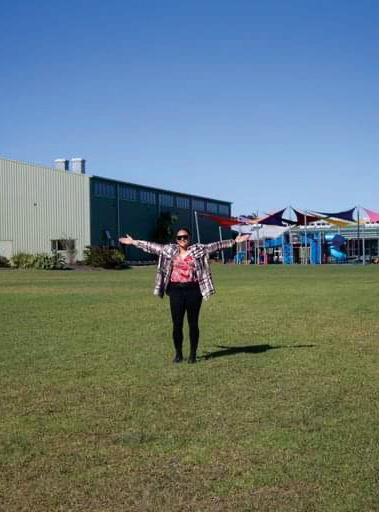




19 Tukutuku Kōrero 6 June 2023 www.smartofficefurniture.co.nz Furnishing Classrooms since 1996 sales@smartofficenz.co.nz 0800 376 373 Te Iri Rangi Tawhara has been an active member of Te Rangi Āniwaniwa in Kaitaia for close to 25 years.
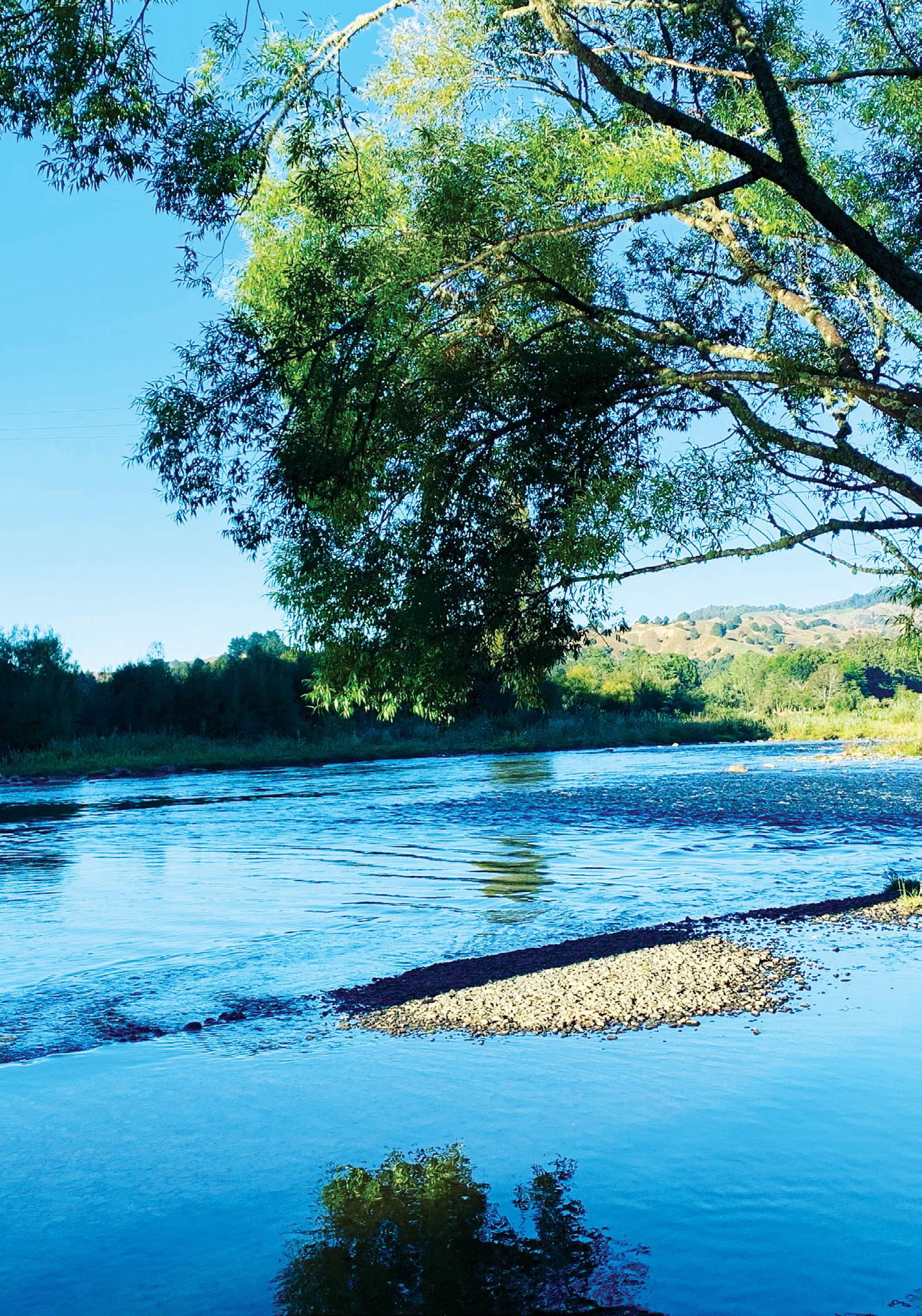 The Whanganui River runs through Central King Country.
The Whanganui River runs through Central King Country.
Meeting the needs of remote rural areas to lift attendance
The challenges of maintaining engagement in learning are exacerbated when students span a remote rural area of the motu. In the King Country Te Rohe Pōtae, distance is part of daily life. But it is proving less of a barrier thanks to the extensive, expert support being offered by an attendance service in the area.
Providing tangible support in a challenging environment, Te Manu Kōrero O Ngā Mātauranga – Rural Education Activities Programmes (REAP) Attendance Service is leading to improved attendance and outcomes for rural students.
“We see ourselves as a conduit between home and school,” says Central King Country REAP education manager Jenny Gawith.
“We support the theory that schools must be able to work closely and engage with whānau to determine the most successful education plan for students. Whānau need to feel included in decisions for their children and their education.”
Te Manu Kōrero O Ngā Mātauranga – Central King Country REAP (CKC REAP) was established in 1980 to provide supplementary and complementary education services for the people of the region. It is one of 13 Rural Education Activities Programmes in New Zealand, based on the belief that local communities are best able to identify and direct resources to meet their specific needs.
Structure is key
Jenny knows the effectiveness of REAP’s suite of support tools and is proud of the impact of its Attendance Service,
not only on individual students, but their schools, and more widely. Practical and strategic engagement are both key, from delivering care and learning packs to liaising with education and welfare organisations on multiple levels.
“Through our mahi at CKC REAP, we have a close working relationship with all our schools. Maintaining structure in the delivery of the contract has been important for it to work well. This structure also ensures accountability from us as the Taumarunui Attendance Service and our obligation to our community.
“For example, we hold an inter-agency attendance hui twice per term. This helps to maintain a close relationship with stakeholders within the attendance space. And we report to the Central King Country Principals’ Association twice per term.”
On the ground, REAP delivers – in many ways. Jenny explains the initial engagement approach.
“Where possible, we meet with the child who is not attending school. If a child is to successfully participate in school, their needs and wants have to be considered. Often, they are overlooked and their voice is not heard. We endeavour to find out from the student themselves their concerns and reasons for absenteeism.”
“We take a care package to whānau on initial visits, so we don’t turn up to their homes empty handed … We try to show empathy and genuine caring to uphold mana and respect for all.”
Jenny Gawith
21 Tukutuku Kōrero 6 June 2023
ATTENDANCE & ENGAGEMENT

Upholding mana for all
A kaupapa Māori approach ensures delivery is consistent and conducive to creating positive relationships.
“We take a care package to whānau on initial visits, so we don’t turn up to their homes empty handed. CKC REAP supports the purchase of some essential items to gift to a whānau, with our packages usually including fruit, tea or coffee, milk, bread, jam, biscuits, cereal and personal hygiene products,” says Jenny.
“Often, whānau are quite scared that their child or children are involved in ‘truancy’. We try to show empathy and genuine caring to uphold mana and respect for all.”
Over the years, Jenny says they have bought school uniforms, lunch boxes, backpacks and stationery and, before the Ka Ora, Ka Ako | Healthy School Lunches Programme was introduced, the service would provide school lunches.
A recent development has been the supply of period products to schools and their students, a lack of which has previously proved to be a regular and significant barrier to attendance.
“Through collaboration with our colleagues from Te Mahau, Te Tai Whenua (central region), we have been able to secure period products for our whānau,” says Jenny.
“We note that ‘period poverty’ is real and certainly impacts on school attendance and participation for some young women.”
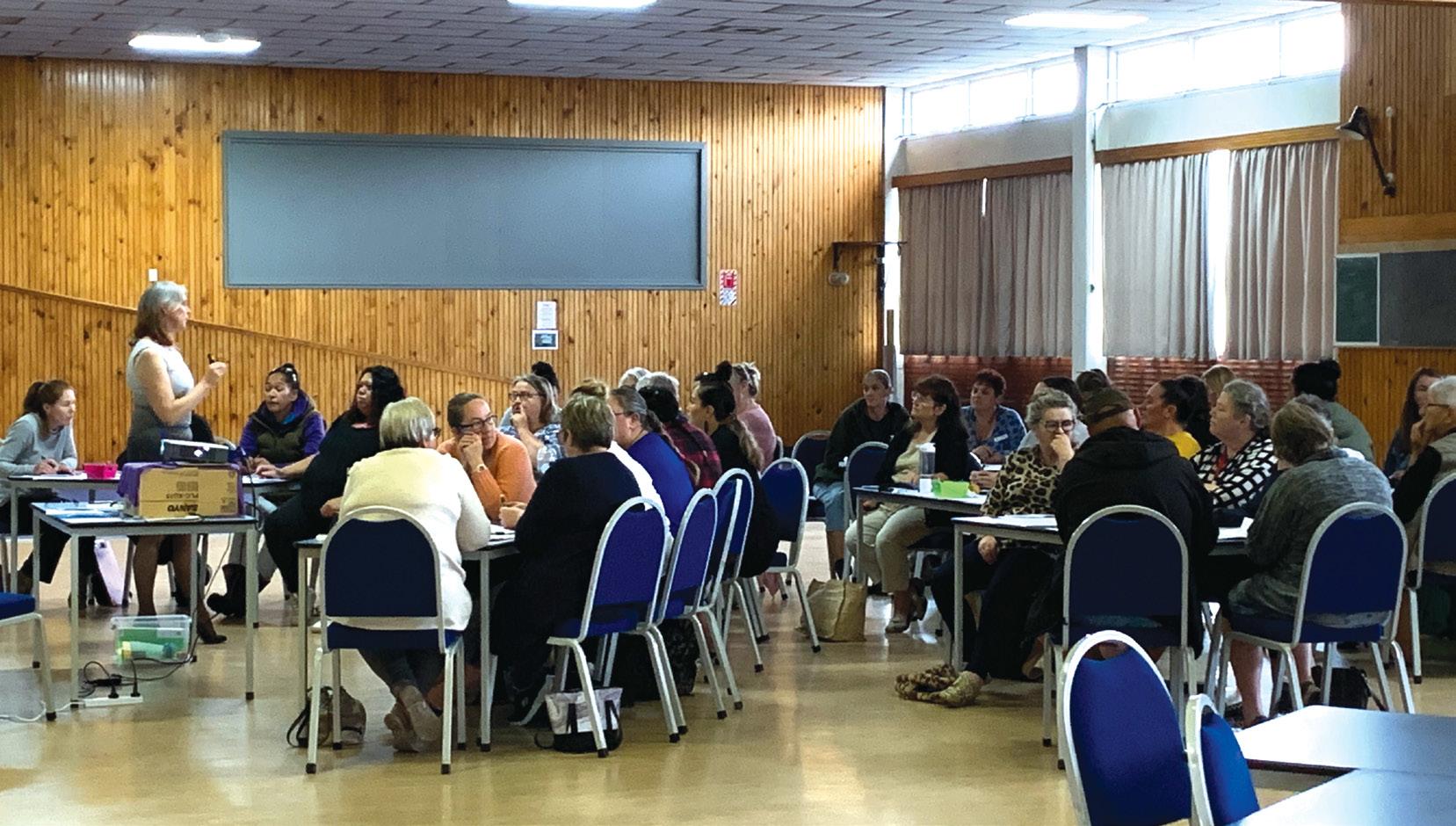
22 Education Gazette gazette.education.govt.nz
Central King Country educators gather together for professional learning and development.
Jenny Gawith and Temorie Wihongi with Felix the Anti-Bullying Mascot for Taumarunui schools.
“Every day counts towards a child’s learning and pays huge dividends for their future.”
Jenny Gawith
Collaboration and community
“We continue to work closely with other agencies and, if needed, we will call upon stakeholders to support us in the attendance space,” says Jenny.
“We use local connections to support our mahi. We have a very close working relationship with local police, especially the Youth Aid constable who supports school attendance. Our Kaumātua have also, at times, helped us to engage with a whānau or a student.”
Working alongside colleagues from Te Mahau, Jenny says they have produced learning packs to care for different age levels, which have been delivered during home visits.
In-school support is provided following home visits to monitor attendance levels and offer additional services that may increase engagement in learning.
“When we return a student to school, we do a couple of visits to the classroom to check on their progress. We try not to close a referral until good attendance patterns are established.”
Another aspect of this attendance lifting work is He Roopū Wāhine Matariki – a weekly programme for young women. The focus of the programme, held at REAP’s Taumarunui base, is:
» Citizenship
» Friendship
» Relationships
» Support (of community, self, and others)
» Tuakana-teina
» Personal self-development
“Attending school on a regular basis is hugely important,” says Jenny.
“Every day counts towards a child’s learning and pays huge dividends for their future. Regular attendance is needed for children to continue learning and improving their basic reading, writing and other skills they need. REAP works to help students and families where attendance is a concern.”
For more information, visit ckcreap.org.nz
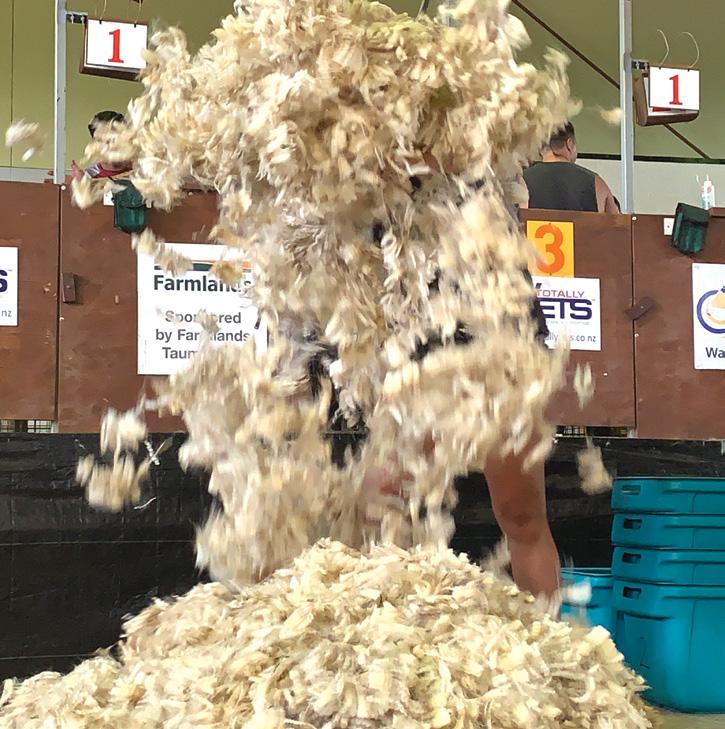

23 Tukutuku Kōrero 6 June 2023
The annual ‘Taumarunui Shears’ shearing competition.


ENVIRONMENTAL EDUCATION
A living, breathing community classroom in Queenstown
Young conservationists at Shotover Primary School are doing their part to restore the regionally significant Shotover Wetland, transforming it into a thriving source of life and learning for the school, and for the community.
24 Education Gazette gazette.education.govt.nz
Year 7 and 8 Enviro Leaders at an autumn planting session.

As the name suggests, Shotover Primary School sits near the junction of two iconic Queenstown waterways, the Kimiākau Shotover River and the mighty Kawarau. The confluence is called Puahuru, a reference to ‘warm waters’ – which they’re not of course, fed by the icy alpine waters of the Basin’s maunga.
Given that the two rivers were part of an extensive network of ara tawhito (traditional travel routes) and mahinga kai for a number of iwi, including Waitaha, Kāti Māmoe and Kāi Tahu, there are varying interpretations of the confluence’s name.
One assumption is that Puahuru was an important junction and at times, a settlement, in which case ‘warm waters’ could refer to a place for warm interactions between people or hapū and a place for whakawhanaungatanga (making connections).
It is most fitting then that a wetland adjacent to this important juncture has become a place where a school community joins together to nourish both taiao and tangata.
The Shotover Wetland, a 10-minute walk downhill from Shotover Primary, has been formally recognised as a regionally significant wetland, home to the at-risk Olearia lineata as well as 21 species of native plants. Bird species observed on the wetland include pukeko, pūtangitangi (shelduck) and kāhu with possible habitat for other local species.
Clearly, this is a space worth protecting and restoring –which is exactly the task that teachers and students have taken upon themselves.
With support from the Whakatipu Reforestation Trust and other community groups, the vision is to “restore this wetland so that it is a thriving source of life and learning for the community, particularly the students of Shotover Primary School”.
Learning opportunities abound, with goals around enabling students to be active participants in a community action group, to make an impact on climate change and to encourage the return of native wildlife.
Conservationists in action
The room is abuzz at Shotover Primary. Today is the first session for a group of Year 7 and 8 students who have elected to be Enviro Leaders this year. They’re seated around trays of yellow kōwhai seeds that they have just popped out of their casings, tuning into Jo Smith, Whakatipu Reforestation Trust’s education officer.
“Look at your seed. Feel it, describe it. Is it hard or is it soft? Smooth or rough?”
She points at a diagram of a cross-section of a seed. “See that yellow coating? It’s called the testa. It’s a hard, waxy coating. The embryo inside is asleep but the coating blocks everything. How, in nature, would the water get in?”
Explaining how they can “fast-forward” natural processes, Jo shows the students how to nick the seed coat with a pair of nail clippers, carefully avoiding the micropyle.
“This is where the radicle comes out, the little root, so we don’t want to tamper with it.”


25 Tukutuku Kōrero 6 June 2023
Propagating kōwhai seeds collected from Pigeon Island by Year 5 and 6 students.
Emma Watts and Jo Smith with the school’s nursery, funded by Trees for Survival.

This

These young conservationists are propagating kōwhai seeds for a new cycle of planting, one of the learning activities that has developed as the project has grown.
Initially the plants were sourced from the Reforestation Trust, with over 2,200 planted since 2016 and now the goal is to get the students growing a few of their own.
“It will take a long time but they could grow up to 25 metres high. We got the seeds from the Year 5/6 students who collected them on school camp. They brought us back the seeds from Pigeon Island,” says Aria, Year 8.
A living classroom
For Emma Watts, leader of Design, Arts, Technology and Science at the school, the wetland acts as a living classroom, offering learning opportunities that extend from ecosystems to climate action.
“Using the wetland they learn about seed dispersal systems in nature, collecting seed, genetic diversity in plants, the function of a wetland, biodiversity, the impact of predators and invasive plant species, water quality plus all the skills and strategies for monitoring the health of an ecosystem,” says Emma.
“If we look at the issue of restoration from a transdisciplinary perspective, there are all these groups active in native planting, monitoring, predator control –and not just mammalian pests but invasive weed species too. The different groups are all working together for one common goal but coming at it from different perspectives.”
Jo Smith agrees that the project is ambitious.
“We’ve got a big plan that’s slowly coming to fruition. It’s all about engagement and being part of nature and learning the different processes that work within it. It’s a natural evolution. And because wetlands are so precious, a lot of our learning is around that.”
Identity
This transdisciplinary approach sits at the heart of Shotover Primary’s philosophy, with curriculum learning for the whole school structured around four macro concepts – Identity, Belonging, Change and Systems which rotate through on a four-year basis.
“This year our concept is ‘Identity’ and our first transdisciplinary theme is Healthy Me, Healthy You, Healthy Communities. We’ll spend about 15 weeks looking at Identity through different curriculum lenses – what does it look like from a scientist’s point of view? A social scientist’s POV? And so on.”
Emma explains that the wetland project offers many learning opportunities around the first theme of the year.
Students learn about the importance of getting into nature for personal wellbeing, discover how wetlands mitigate flooding and filter water for the community and the importance of biodiversity for community health. They also have an opportunity to get their hands dirty and do something about climate change.
26 Education Gazette gazette.education.govt.nz
year, students are trialling cardboard guards to protect the plants from rabbits.
“It’s that direct action. We can sit and watch a video or have someone come and talk to us about climate change, but often students want to do something, and they want to do it now.”
A long-term project
With the help of Bonnie Wilkins from Southern Lakes Sanctuary, students have set up tracking tunnels to monitor which predators are around, and the next step is to lay a trapline for mammalian predators.
“We track the pests using tracking tunnels and chew cards with an app called Trap NZ that helps us track what pests are in different areas. We found a lot of hedgehogs at the fenceline of the wetlands which is where they like hanging out,” says Archie, Year 7. “Some people think, ‘Why are you killing the hedgehog? They do nothing.’ But it turns out they eat all the bird’s eggs that nest on the ground.”
“We put traps out to try to get rid of pests because if we get rid of the pest then plants can grow better and they will stop killing our native birds,” adds Finnley, Year 7.
From there, the students will increasingly be involved in monitoring the health of the wetland – carrying out bird counts, photopoint monitoring to compare the growth of plants year on year and measuring water quality with support from the local council’s scientists.
“To me that’s the most exciting and challenging thing,” smiles Emma, “that the whole wetlands project doesn’t just happen for a term.
“It’s not like we can go ‘tick, we’ve done climate change or biodiversity’. It’s a long-term project. It’s growing the plants, planting them, monitoring, going back to check regularly to make sure that we’re making a difference to the health of the wetland.”

“It’s all about engagement and being part of nature and learning the different processes that work within it. It’s a natural evolution. And because wetlands are so precious, a lot of our learning is around that.”
Jo Smith

27 Tukutuku Kōrero 6 June 2023
Laying tracking cards to identify mammalian predators is the first step to setting up a trap line.
 Empowering a generation of ‘Girl Bosses’ in healthcare, science and sport PATHWAYS
Empowering a generation of ‘Girl Bosses’ in healthcare, science and sport PATHWAYS
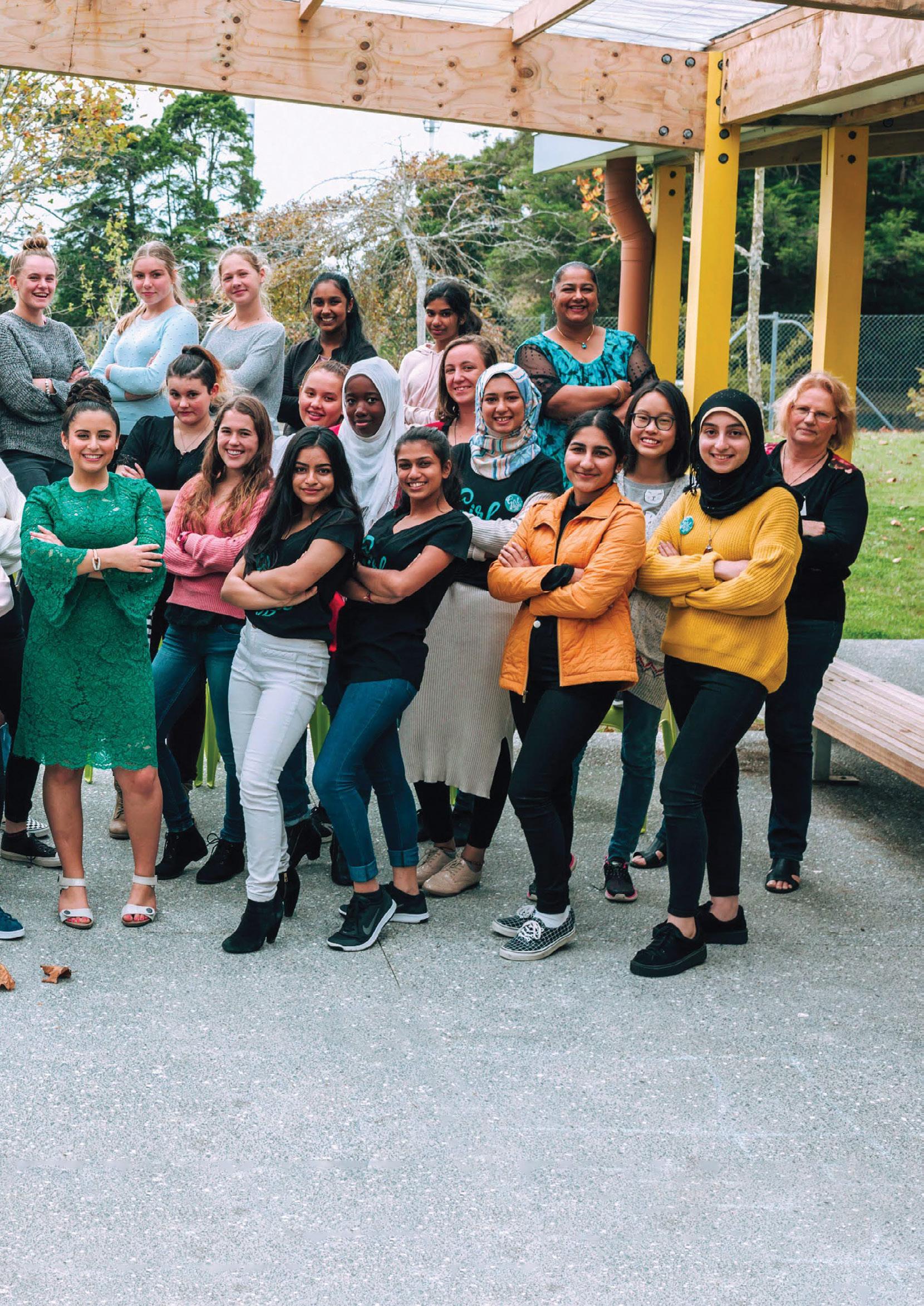
GirlBoss New Zealand’s most recent offering, GirlBoss Edge Healthcare, has supported a new wave of wāhine to forge their own path into industries like health, science and sport – and to be unapologetically ambitious in reaching their potential.
With the upcoming FIFA Women’s World Cup Australia and New Zealand 2023™, now is the perfect time to create and deliver new and exciting opportunities for girls and young women.
29
Mana wāhine at a GirlBoss
Future CEO Summit.
 Alexia Hilbertidou.
Alexia Hilbertidou.
GirlBoss New Zealand founder and CEO Alexia Hilbertidou says participants in their latest programme are “part of a wider movement and wave of empowered, confident women who are stepping forth into these industries and are having an incredible impact in these fields.”
GirlBoss Edge Healthcare took place over the April school holidays as an interactive 10-day school holiday programme. It was rolled out online and featured a series of Facebook Live events, Q+A sessions, team challenges, kōrero and one-on-one mentoring from over 150 healthcare professionals including doctors, surgeons, midwives, and CEOs.
Edge Healthcare application numbers were estimated to sit at around 400. To the great surprise and delight of GirlBoss NZ, the series garnered nearly 1,000 applications. They were granted extra funding to offer full ride scholarships to 825 young women.
The programme was funded by the Ministry of Business, Innovation and Employment to raise the profile of women and girls in society as part of co-hosting the FIFA Women’s World Cup 2023™.
Across all of the GirlBoss NZ programmes, there is focus on enabling engagement and interaction between the mentors and the network of young women.
The virtual events are carried out in a way that champions collaboration and strays away from a traditional speaker and passive listener interaction. This sets them apart from other online programmes and is why their community keeps growing.
“You’ll never see a GirlBoss event where a young woman is just sitting there passively in the crowd, listening to someone else speak on stage and then going home. We’re not in that game. We’re in the game of action and genuine confidence, which is built through experiences and pushing yourself outside of your comfort zone.”
Edge Healthcare speakers and mentors included health industry professionals like Jazz Thornton (mental health advocate), Dr Hinemoa Elder (psychologist, forensic psychiatrist, and neuroscientist) and Dr Justin Sung (former medical doctor, author and co-founder of Foster Our Future, a New Zealand registered charity aimed at reducing education inequities).
Like all GirlBoss initiatives, Edge Healthcare was designed to be active rather than passive, with participants expected to execute plans, and move from a state of inspiration to real action.
“We teach them how to introduce themselves to somebody, how to go up to somebody at an event, how to do an elevator pitch. They’re learning everything, and then they put it into practice the next day, which is cool. They can solidify their learning.”
Participants of Edge Healthcare were given an unmatched experience and skills that will benefit them when taking the first steps on their professional journey.
“What we’re doing is teaching key career skills, they’re getting a CV worthy experience, and joining a
community and network. Every single day they’re doing different things and it’s a very challenging environment because we want them to emerge with genuine confidence.”
In addition to gaining industry connections, learning CV preparation and creation, and undertaking problem solving challenges, it was hoped all participants would leave the course with something far more important and invaluable – inner confidence and self-assurance.
“Every single young woman who did that programme now knows how to introduce themselves, how to answer the question, ‘what do you want to do once you leave school?’ and say it in a really positive and compelling way.”
Following the commencement of the programme, feedback from attendees showed that 90 percent of alumni felt the course was life-changing for them. For Alexia, that is the key metric to measure success of the programme, and it’s also the ‘why’ behind what she does.
“You can have a conversation that provides an experience to a young person which completely changes the trajectory of their lives. That’s something very special and unique in the education space.”
Alexia Hilbertidou
The girl boss behind GirlBoss
GirlBoss NZ was founded in 2015 by Tāmaki Makaurau local, Alexia Hilbertidou. At 16 years old, while a student at Albany Senior High, Alexia developed the now 13,500 member strong network of young women.
Throughout her education, Alexia went to a number of schools dotted across East and West Auckland and the North Shore. Raised by a single mum who worked as a teacher, furthering knowledge and seeking higher education were values held in high regard in the household. Naturally, Alexia has come to love education in all forms, both educating and being educated.
“You can have a conversation that provides an experience to a young person which completely changes the trajectory of their lives. That’s something very special and unique in the education space.”
GirlBoss NZ programmes help young women who are looking to enter into, and succeed in, fields such as science, technology, engineering, maths, entrepreneurship and business. Their various offerings equip participants with LinkedIn accredited skills, ongoing mentoring, specially developed professional coaching, and a large network of supportive wāhine.
31 Tukutuku Kōrero 6 June 2023
Seven years on, the GirlBoss NZ community has seen immense growth – both by way of member numbers and the empowerment gained by being part of the network. Over 13,500 young women from one hundred secondary schools across Aotearoa are involved in GirlBoss NZ and the initiatives rolled out by Alexia and her team.
Bright and bold leaders
GirlBoss NZ is funded by corporate and government sponsors including Spark, PwC, ANZ and the Ministry of Education and Ministry of Business, Innovation and Employment, which allows them to roll out their initiatives at no cost to participants. This was imperative to Alexia and the philosophy of the organisation.
“It’s all about breaking down bad boundaries and barriers. Because if we want to change some of the statistics, we can only do that by making it more accessible and equitable to everyone.”
Many young female school leavers and university graduates enter the corporate world without any previous experience of professional environments or knowledge of socially agreed norms of professional conduct, says Alexia.
When these circumstances are paired with other systematic disadvantages like race, poverty and levels of education, young women are even less likely to thrive professionally compared to their male peers.
“What I’ve seen through my journey as someone who came from a single mother background in West Auckland, to now being in Forbes 30 under 30, being a Queen’s young leader, working with senior leaders across the world, is
the biggest barrier for young woman from low income backgrounds, who are first in their family to go to university, is the ability to navigate corporate and professional environments.”
They also tend to have to navigate these changes alone, without the same wraparound support that classmates or university peers can provide.
“Even the most talented young women – bright and bold leaders – as soon as they’re put into a corporate environment, I will watch them shut down, become a shell of themself. They’ve got imposter syndrome – no one in their family has worked in a corporate job before. There’s so much inequality that comes into play, which has nothing to do with their capabilities or potential as an individual.”
Feelings of inadequacy, uncertainty and imposter syndrome are natural when transitioning to new stages of life. Regardless of the universality of these feelings, they are still no less difficult to deal with.
“It’s okay to feel fearful. But it’s not okay to let that fear get in the way of your contribution to this world,” says Alexia.
In high school, Alexia noticed opportunities like internships and self-development programmes were largely given to her peers in traditional leadership roles or were more accessible to those with a higher socioeconomic status and established connections.
With GirlBoss NZ, Alexia champions the principles of equity and accessibility, so there are no prerequisites or fulfilment criteria that participants must meet in order to be part of the community.
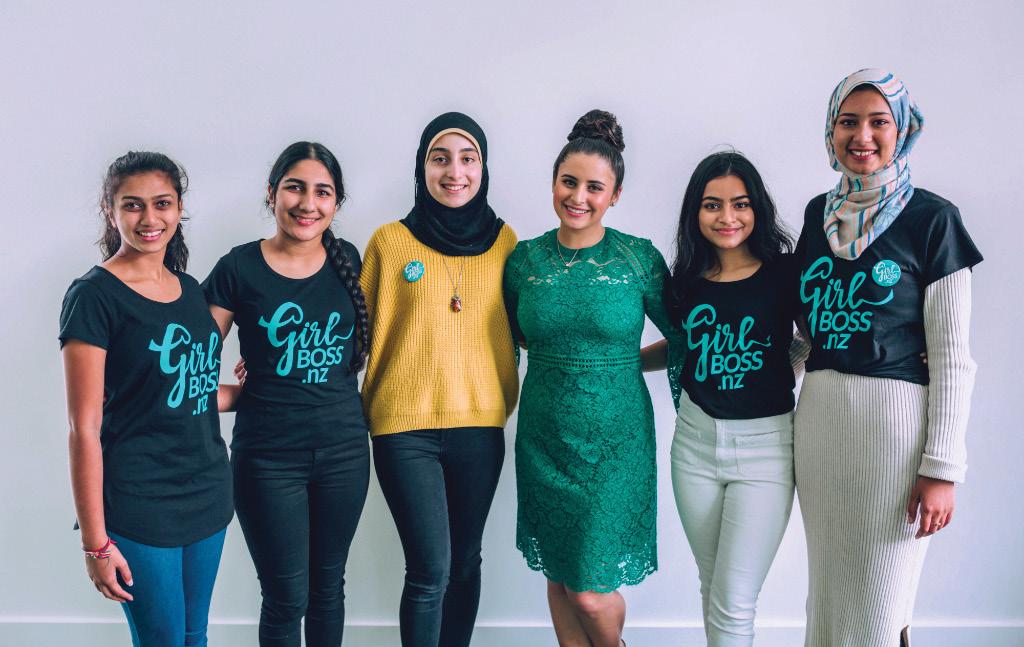
32 Education Gazette gazette.education.govt.nz
GirlBoss aims to break down barriers at Future CEO Summit.
“A drop of a leaf on a calm lake can create endless ripples of change. A positive change I would like to make in this world is to design technology that can help people.”
Leticia, 17
The only unofficial attribute or requirement of members is that they are engaged, want to join a supportive community of young wāhine, and determined to make positive change in the world.
Building on momentum
The momentum GirlBoss NZ has already gained, alongside their grassroots connections, will ensure a continuous delivery of events and programmes that exceeds expectations.
Over May and June, the GirlBoss NZ team is travelling across the country to run activations at campus Career Expos, attend several speaking events, and host ‘Hackathons’.
The latter is what Alexia is most excited for following the success of last year’s all female Hackathon, ‘We the Women’. The 2022 Hackathon was sponsored by Spark, PwC, and ANZ. Off the back of the event Spark gave 25 percent of participants paid employment and ongoing mentorship.
“We never just let the sponsors be passive. We want to give our young women exposure to these careers and fields, get connected in corporate organisations, and get work experience.”
The upcoming Hackathon has a focus on the UN Global Goal (SDG 5) – Gender Equality. It will see a community of young women come together to hear from inspiring speakers and work in teams to develop and present a problem-solving policy.
“We’re really encouraging young women to be unapologetically ambitious, to dream big, to realise that they already have everything within them to go out there and achieve their fullest potential – they don’t need permission from anyone else.”
GirlBoss-es of the future
Aleynna, 16, Manurewa College
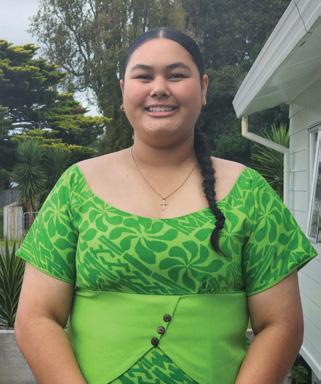
Aleynna says before GirlBoss Edge, she struggled to get out of her comfort zone and socialise with others.
“I met many extraordinary young women who have the same interests as me. I have become so much more confident. The key thing I take from this programme is no matter where you’re from, you can be successful just by following what you’re passionate about.
“I love to help others, whether it’s mentally, spiritually, physically, socially, or culturally. A positive change I want to make in the world is to encourage other Pasifika students to embrace and explore their cultures because it’s a big part of their identity and also to help and encourage other Pasifika students who want to be a part of the medical industry who are afraid of failure or think they aren’t capable of being in the medical field.”
Leticia, 17, Marist College
Leticia says her whole entire life has changed, along with her views on the healthcare industry and the professionals that work within it.
“I feel as though I have a chance to participate in the industry and create a positive impact. Honestly, it’s mind-blowing how much I have learned within 10 days of this programme compared to my entire 17 years of living.
“A drop of a leaf on a calm lake can create endless ripples of change. A positive change I would like to make in this world is to design technology that can help people. I aim to study biomedical engineering, or maybe I may choose some other path to be a researcher or some sort of pharmacist. Either way, it is fulfilling to use my skills to make people’s lives easier and more manageable.”
Read this article online to learn more about how and why Alexia developed GirlBoss NZ, and see some of her greatest advice for tamawāhine.
You can also read about 15-year-old Darcy and 17-year-old Diya’s experience of GirlBoss Edge.
6 June 2023
Collaboration, not competition
Throughout July and August this year, Aotearoa will host the FIFA Women’s World Cup 2023™ alongside Australia – it’s the world’s largest women’s sporting event and is expected to encourage necessary conversation on the representation and treatment of women in sport and media.
As part of the Leverage and Legacy programme, the Ministry of Education and Ministry of Business, Innovation and Employment have partnered with GirlBoss NZ to facilitate events for the duration of the World Cup.
“This is an excellent example of how we can leverage major events such as the FIFA Women’s World Cup to empower future generations of Aotearoa New Zealand and leave a lasting legacy for our country and our communities,” says Kylie Hawker-Green, MBIE manager major events.
The programme is supported by a fund to mobilise outcomes in four key focus areas: Mana Wāhine (raising the profile of women and girls in sport and wider society); Te Tangata (thriving communities); Te Ao (enhancing our international relationships), and Ōhanga (economic growth).
“Sport is such a good tool to talk about issues like gender equality and the gender pay gap. It can help when teaching key leadership themes like fear of failure, imposter syndrome, resilience, and confidence. It can also help reach young women that may not be engaged in other areas. These topics are very much on the pulse at the moment,” says Alexia.
Another possible avenue for learning is the importance of teamwork which is innate to sports. Teamwork is an everyday principle practised in the GirlBoss community and it contributes to their overall success and objectives.
“We talk a lot at GirlBoss around the importance of collaboration, not competition, and lifting each other up, supporting each other and making all of our dreams a reality. Because when we step into our potential, we’re not just changing our own lives, we’re changing the world,” says Alexia.
Alexia is grateful for the partnership with the Ministry and MBIE as it will allow the organisation to raise their profile further and extend their reach across Aotearoa.
“We’d love for any young women or teachers to sign up to our newsletter. We’re always looking for connections in schools because it’s so important to have a teacher as a contact who can champion what we do. We want to keep doing the work that we do and reach more young women.”
“Sport is such a good tool to talk about issues like gender equality and the gender pay gap. It can help when teaching key leadership themes like fear of failure, imposter syndrome, resilience, and confidence.”
Alexia Hilbertidou
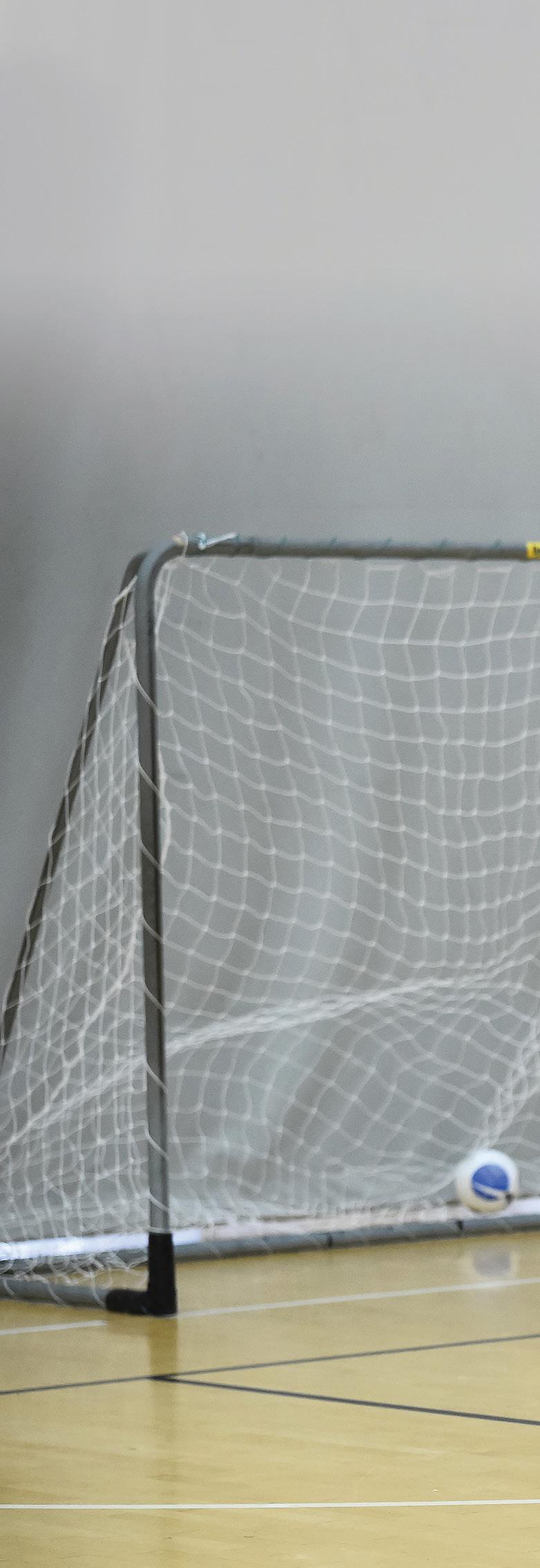
34
Beyond The Pitch
FIFA Women’s World Cup 2023™ have launched an immersive tournament-themed classroom education programme aligned with The New Zealand Curriculum.
Beyond The Pitch is for primary and intermediate aged students and includes a range of lesson plans designed around the FIFA values of Diversity, Excellence, Equality, Passion, Respect, Authenticity and aligns with the Social Sciences, Health and Physical Education, Personal Health and Development, and Technology curricula.

Built in collaboration with New Zealand Football and Sport New Zealand, Beyond The Pitch sits alongside Sport New Zealand’s ‘In Our Backyard’ educational project, in the Kōtuitui learning module.
The hub includes a range of tournament-themed lessons and workshops, as well as an excursion section for teachers to arrange outside the classroom experiences by attending a match or a FIFA Fan Festival.
Find these resources at FIFA.com/beyondthepitch.
35
STUDENT AGENCY
Setting ākonga up as true innovators in business and beyond
Since he began teaching commerce at Christchurch’s Cashmere High School in 2018, Matt Benassi sought to bring the city’s reputation as a dynamic startup hub into the classroom.

36 Education Gazette gazette.education.govt.nz
Matt Benassi with his students at the 2022 Electrify Aotearoa: Women Founders Conference.
Through innovative and responsive practices, Cashmere High School teacher Matt Benassi has led his students to success in the Young Enterprise Scheme (YES), and in 2019, he was named ‘Most Inspiring Teacher’.
“We want our students to have a sense of agency and a sense of understanding,” says Matt.
“This generation … they’re just thriving. They want to be able to have this ability to think creatively and innovatively and turn a side hustle into a main hustle,” he continues, adding that young people – now more than ever – are asking, how can they create income for themselves without having to get paid by someone else?”
Matt’s learners are hungry for success, but teaching a subject in which success isn’t always guaranteed comes with unique challenges.
In entrepreneurship, “you have to feel okay to try something and then go, ‘well, that didn’t work’,” he explains.
“You could be so close to getting it right, but if you don’t do it again, you won’t. Sometimes having those conversations can be quite difficult.
“That’s where a teacher needs to step in as well and provide a bit of guidance. I think when learning it’s like riding a bike… you want to feel off balance so that you can get balance, but you also don’t want to continuously hit the ground.”
Knowing when to step back and when to engage is a big part of Matt’s teaching. This was one of the many innovative practices that brewed success at the 2019 YES awards, when a team from Cashmere High School won the coveted Company of the Year and Innovation awards for their product, Pivot – a sports strapping tape that cools on contact with water.
“That was a world first,” says Matt, adding that the competition’s judges searched for similar products and came up short.
Cashmere’s team were true innovators.
“They were resilient,” says Matt. “We allowed them to network and find enough connections. Plus, they had friends in another class and they became rivals – their friends pushed them.”
Thinking outside the box classroom
Another innovative practice centres on the belief that effective learning can and should occur outside the classroom, says Idoia Alday Gonzalez, Canterbury’s Young Enterprise Scheme coordinator.
“Matt pushes his students to take up any ‘out of the classroom’ opportunities and experiences that are made available to them – putting them out of their comfort zone but later seeing great transformations in students’ abilities and confidence,” she says.
Matt also encourages learners to engage with working entrepreneurs and business leaders – many of them former Cashmere students.
Idoia explains that through this experiential learning, “you end up with a team with great determination that can work with a professionalism beyond their years.”

“When everyone’s kind of got this shared disruption, you start to think a bit more creatively, it provides you opportunities to try things that haven’t been tried before.”
Matt Benassi
37 Tukutuku Kōrero 6 June 2023
Students Jack and Archie won the national Innovation Award for their product, Total Card, an electronic business card made from wool.
Ultimately, she says a key takeaway from Matt’s practices is that while “great teaching happens in schools, the best learning comes from being involved in the community and learning from those who have walked the walk.”
Diverse disciplines
The timetable and programming restrictions of large schools like Cashmere present some hurdles for learners seeking to engage in extracurricular/co-curricular opportunities.
To help clear these obstacles, Matt is always seeking opportunities for commerce to cross over into other subjects, explaining that successful entrepreneurship is the marriage of a diverse array of disciplines.
Nonetheless, he admits a degree of trust dictates his approach to workload and scheduling among his students.
“It’s a busy school. Students have to prioritise, and they have to ask themselves ‘what’s the most important thing I need to do right now?’ ” Matt explains.
He says his role is less taking learners where they need to go, and rather, providing them with the opportunities and tools required to get there themselves.
“A lot of times you have to be okay with not necessarily knowing the outcome but trusting students will learn and get it. One of the ways I instil this, is that whenever we go anywhere like Ara Institute of Canterbury, I tell the students, ‘I’ll meet you there’ not, ‘I’ll take you there.’ I set everything up so that if there are any problems, they can call me, they can get a hold of me, and I will help them problem-solve it but that’s an element they need to be able to do themselves.”
In order for this philosophy to work, however, Matt says it’s essential for a teacher to first know their students. One way he achieves this with his Year 13s is to assign them small challenges in the first month of the school year.
“Part of that is to see how they respond,” says Matt. “Part of that is to break down some of the elements of other subjects, where you’re not aiming to fail and to have that creativity without having to have that ownership.”
This process helps Matt get to know his students to the point where, when they start creating their own products,
he’s able to provide guidance that accounts for learners’ strengths, insecurities and passions.
It takes a village
Idoia describes Matt’s classroom as “a village, where everyone does not just compete against each other but they also support each other to excel.”
She says this results in lasting relationships, not only between students but between students and faculty as well.
Because of this, Matt is able to invite past students to inspire current learners – a testament not only to the success of his processes but also to the bonds they forge in and outside the classroom.
Matt explains that this practice in particular acts in the spirit of 2020’s National Education and Learning Priorities (NELPs), specifically the points concerning collaboration and imparting skills learners need in education, work and life.
“Students should be expecting that they are learning something that they can use outside of school that’s going to be real,” says Matt, adding, “Guest speakers always enhance the students’ experience. They bring their expertise from the industry that teachers can’t always offer. So they give you a different perspective or they enhance what the teacher is saying.”
Looking back, Matt says Cashmere’s current commerce department has evolved a lot over the years. It adapts and progresses each year. New opportunities like the Young Enterprise Scheme only started when Matt arrived in 2018. Ultimately, he believes the last five years of rapid change – and disruption – were beneficial to his teaching.
“The longer you go on doing the same thing, the harder it is to try something new,” he says.
“I think that’s what’s going to happen with the new NCEA alignment. Nobody knows what it’s going to look like. We can read about it and we can picture it, but until we do it, it’s not familiar.
“When everyone’s kind of got this shared disruption, you start to think a bit more creatively, it provides you opportunities to try things that haven’t been tried before.”

“Great teaching happens in schools, [but] the best learning comes from being involved in the community and learning from those who have walked the walk.”
Idoia Alday Gonzalez
38 Education Gazette gazette.education.govt.nz

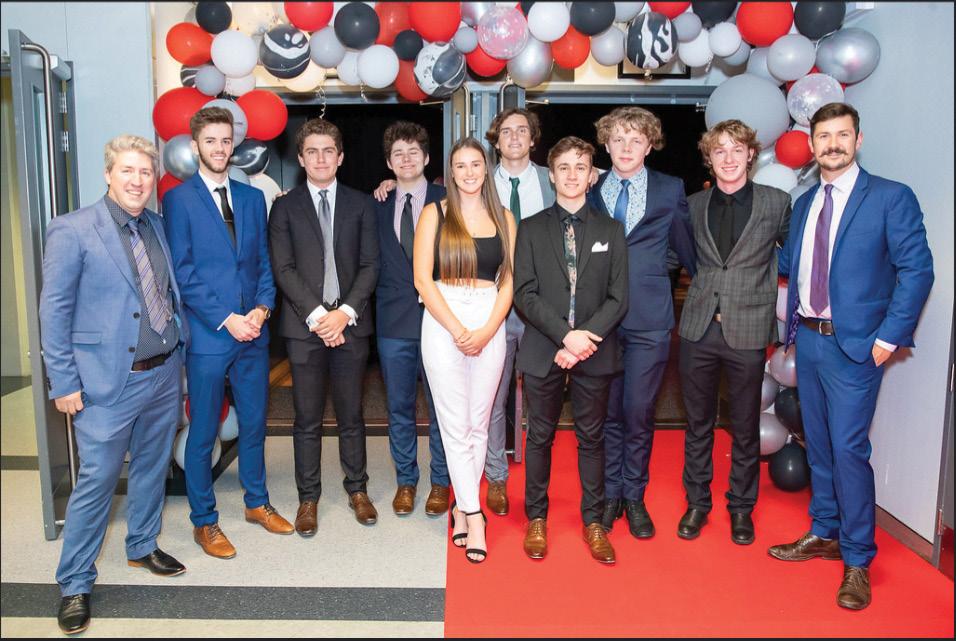
“This generation … they’re just thriving. They want to be able to have this ability to think creatively and innovatively and turn a side hustle into a main hustle.”
Matt Benassi
39 Tukutuku Kōrero 6 June 2023
Cashmere High School won Company of the Year at the YES Awards in 2019.
Matt wins the Most Inspiring Teacher award.
Ākonga step ahead with stronger problem-solving skills
A social emotional learning curriculum trialled in some schools in Waitematā is already having an impact, with teachers and students reporting better problem-solving skills and emotion control.
STEPS-A (Skills Training for Emotional Problem Solving for Adolescents) is a social and emotional skills, evidence-based, training programme for rangatahi, with the curriculum divided into four main modules: mindfulness, distress tolerance, emotion regulation and interpersonal effectiveness.
The sustainable intervention offers schools the capacity to identify students who may be at risk of developing, or already be experiencing, mental health problems. The programme was first trialled in three secondary schools in West Auckland in 2018 and 2019 in response to the Child Youth and Family Mental Health Service seeing an increase in referrals, and schools reporting an overwhelming number of students who needed support.
Skills for life
This year, the early intervention programme has been adapted for intermediate school students, with 15 schools involved in a trial across North and West Auckland. Te Whatu Ora – Health New Zealand’s Marinoto Child and Youth Mental Health Services is running the apprenticeship training model for intermediate schools.
The aim is to teach the skills using different modalities: reading, discussion, small group work, watching and analysing a video in relation to skills, or doing a practical activity to reinforce the skills – sometimes in the form of a group work activity, mindfulness activity, a game or making a sensory tool.

Mienki, Year 7, and Bella, Year 8, look at examples of sensory strategies and think about what they could use in their daily lives.
WELLBEING
“Also known as DBT (dialectical behaviour therapy) skills in schools – the DBT STEPS-A programme teaches students good life skills to cope with whatever life throws at them,” says Kirstin O’Connor, STEPS-A acting team lead, Child Youth and Family Mental Health Services, Te Whatu Ora, Waitematā.
“It’s a 30-week programme, run for an hour per week in schools alongside two of our STEPS-A coaches and at least two staff who may be school nurses, guidance counsellors, deans, senior leaders, classroom teachers or SENCOs. We’re supporting them to feel comfortable in running the programme after that 30 weeks,” she explains.
The team is mindful of the need to ensure the programme is culturally appropriate. There is a broad mix of cultures within staff and students, and recruitment is currently underway to appoint a cultural advisor. Auckland University of Technology (AUT) will be reviewing the project and part of this evaluation will look at cultural support and where adaptations may be needed to ensure it’s culturally sustaining.
“As we are in the pilot phase, our delivery team is working closely with schools and teachers to adapt and ensure the programme meets the needs of students in each group,” says Kirstin.
Encouraging results
Kirstin says partnership with teachers has been good for early intervention.
“We obviously have a relationship with schools, but that’s at the end when a student is really unwell. So it’s nice to have relationships with the schools being built earlier on,” she says.
The programme has been adapted for intermediate schools due to an increase in young people presenting with difficulties.
An initial trial at Murray’s Bay Intermediate in 2020 was very successful, with Kirstin saying, “Findings from this trial showed a reduction in the time students required from school staff, enabled students to better manage their emotions and behaviours, and improved their ability to learn, while also reducing office referrals and disciplinary action.”
These results mirror those found in clinical trials in Ireland and North America where participants reported significant reductions on overall emotional distress scores when compared to peer controls.
Tools and strategies
Devon Hiley is a Year 7/8 teacher at Massey Primary School and jumped at the chance to be involved.
“After Covid, every school will identify that anxiety is so much higher across Aotearoa. If the programme only works for one of the students in that group, then that child has skills they can pass on to others,” she says.
Alongside programme facilitators Susannah Limbrick and Lauren Glass, Devon is a familiar face for the 13 students who have been handpicked from across the Year 7 and 8 cohort.

“What we’re doing is teaching skills to navigate and manage different situations. The skills lend themselves to any kind of group that is struggling.”
Kirstin O’Connor

41 Tukutuku Kōrero 6 June 2023
Top: A STEPS-A manual.
Bottom: Akonga made a small sensory pouch with different objects and shampoo: a sensory item to take home which incorporates touch, vision, smell and is a self soothing fidget item.
“There’s a mixture of some students who have gaps in their ability to emotionally regulate in any high emotion environment, as well as some of our future leaders who need help managing the stress and anxiety that comes with those roles.
“We have students that come from very tough backgrounds. We think it’s important to give them some tools and strategies to draw on. It’s early days still, but we do see them drawing on it a bit. But also, the parents love getting the emails I send each week – they’re all really on board.”
Huge progress
Devon says her role is to observe, take plenty of notes and act as a communicator between the facilitators and parents.
“I send an overview home each week of what we have done because some of it can be quite heavy stuff for the students, so the families have an idea what we’ve talked about and also can relate back to it at home, reinforcing the learning.”
While the students were initially nervous, she says that apart from illness, not one student has missed a session.
“I’ve seen the direct use of the skills in class. At this age little incidents happen – and I’ve been able to say,
‘How are we dealing with this? Are we making it bigger, are we making it smaller?’ At the moment, it’s getting them to see how they can use it and it takes time.
“The teachers get the notes from me, and they are able to say, ‘Hey, are we using our logical brain, or our emotional brain? How do you think we’ve dealt with this? In future how do you think we could deal with this?’
“I was so proud – one of my girls came in at the end of the holidays and said, ‘I had a right tantrum in the holidays. But then afterwards I was so annoyed with myself because I was in my emotion mind and not in my wise mind.’ The fact she’s using the language we use in the course is amazing.”
Changing mindset
Next year Devon hopes to run the programme with her class, as well as training and supporting colleagues.
“All children would benefit from this. That is the reason I am learning as well, so that I can take it next year.
“Last week we were doing art and one of the skills we had been learning was around observations and judgements; so rather than saying ‘I hate my artwork’, we took that opportunity to explain that it’s a mindset thing and finding an opportunity to find a different perspective.
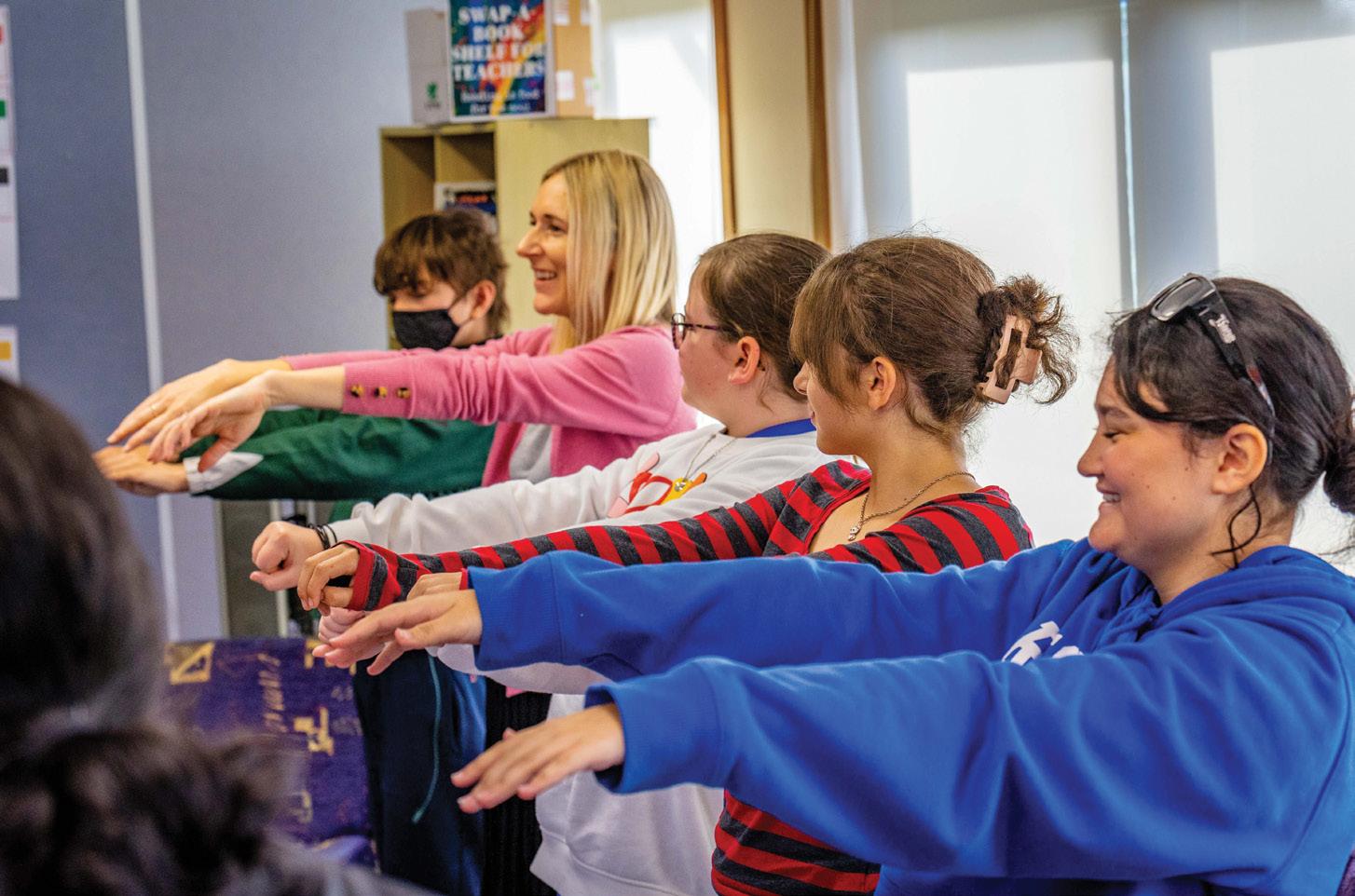
42 Education Gazette gazette.education.govt.nz
An exercise to observe how encouraging thoughts can help manage uncomfortable emotions and sensations.
“That’s a tiny little lesson from the whole programme, but if one of the students in my class takes that on, they’re benefiting from this course as well and that’s so important,” says Devon.
Cascade of consequences
Kirstin says the programme has been adapted for adolescents from the skills training programme in Dialectal Behaviour Therapy (DBT) developed by Dr Marsha Linehan, a professor at the University of Washington.
“We’re getting feedback from parents that some of the students are less angry, more engaged and able to cope with the everyday difficulties of being a preteen. For example they’re not getting involved in fights –where they might have previously been involved in a physical altercation.
“The success has been in allowing students the space to step back and think about that cascade of consequences that might happen if they behave in an unskillful way,” she says.
The intermediate school’s mahi is mid-trial, but some testing was done at 15 weeks, half way through the programme, and Kirstin says the data shows that coping skills have improved.
“We do five psychometric tests with students at the
start of the programme to get a base line level. We look at their coping skills before the programme and we do another one at the end of the programme to understand if there has been an impact. We’ll have a lot more information at the end of term 2.”
It is also hoped the programme will help students who are being bullied.
“These days if bullying is happening there isn’t a separation between home and school – it can happen 24/7 and so there’s no separation and ability to process something that happened at school.
“So if you are someone who is vulnerable, or doesn’t have good coping skills and are being bombarded, it’s going to be much harder to make a good decision. The hope is that these skills are going to support young people to feel like they have a bit more of a kete – an array of things to draw from,” says Kirstin.

43 Tukutuku Kōrero 6 June 2023
Read this article online for links to more information about DBT.
The STEPS-A team, Lauren Glass, Susannah Limbrick and Kristin O’Connor, with teacher Devon Hiley (back) at Massey Primary School.
What ākonga and whānau are saying
Ākonga voice
What do you like most about being part of the STEPS-A programme?
» It teaches us how to control our emotions. Learning how to manage myself and emotions better. Mienki, 12
» Having friends in the course makes it more fun. Charlotte, 12
» It helps us to control our emotions in different ways, so we don’t get overwhelmed. Bella, 12
What are some of the key things you have learned?
» If someone mocks us, we know how to deal with it instead of reacting in a bad way. We learned about the three minds: wise mind, emotion mind and reasonable mind. We want to make decisions when we are in our wise mind so that we think of other people’s feelings and what consequence our actions might have. Bella
» Identifying which mindset I am in: wise, reasonable or emotional and trying to change it. Also, how to distract myself when I am in distress. Charlotte
» Wise mind – what it is and how to get to it from reasonable and emotion mind. Mienki
Do you think the things you are learning will help you in life?
» It will help me deal with complicated situations that I wouldn’t know how to deal with without the course. I can deal with problems in a more responsible way. Mienki
» Everything we have learned so far teaches us how to cope with how we feel and how to avoid actions and words we might regret when we are mad. Charlotte
» The strategies and skills might help us to take risks and step outside of our comfort zone. Bella
Whānau voice
Why did you think this programme would benefit your child?
» I thought this programme would benefit my child because I know how much it has helped me as an adult. I would have loved to have learned these skills much earlier in life, and I believe everyone could benefit from a course in DBT.
Have you noticed any changes in your child? If so, can you give an example?
» I think my son is still settling into the course. However, recently, after a series of conflicts between him and his siblings, he was able to mindfully reflect on his attitude and state of mind and how this may have contributed to the conflict. He was then able to think about ways to work through those emotions without making the situation worse for himself or others.
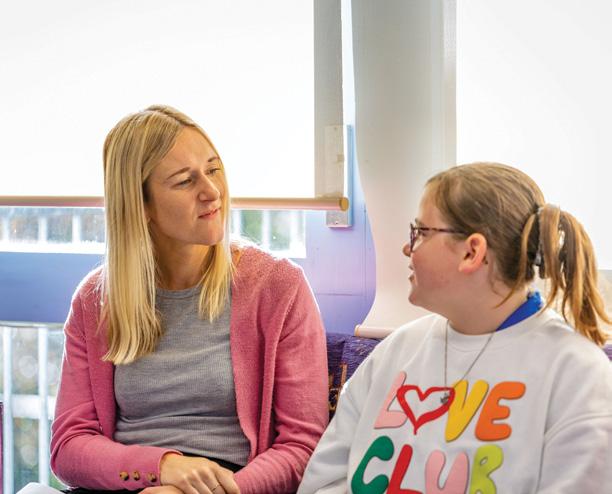
“I was so proud – one of my girls came in at the end of the holidays and said, ‘I had a right tantrum in the holidays. But then afterwards I was so annoyed with myself because I was in my emotion mind and not in my wise mind.’ The fact that she’s using the language we use in the course is amazing.”
Devon Hiley
44 Education Gazette gazette.education.govt.nz
Lauren Glass with Year 8 student Charlotte.

Positive learning environments
Ākonga learn best in positive environments that nurture their social, emotional, and cognitive skills, and in which they are free from bullying and discrimination.
SEL
Social & Emotional Learning (SEL) enhances students’ capacity to integrate skills, attitudes, and behaviours so they can deal effectively with daily tasks and challenges –it is most effective when it is part of daily classroom life.
Approaches to support the social and emotional development of ākonga look like:
» Using modeling and coaching to help ākonga recognise how they feel or how someone else might be feeling.
» Teaching ākonga to use conflict-resolution skills and use dialogue to guide them through the steps to help them apply a skill in a new situation.
» Practising group decision making and setting classroom rules in class meetings.
» Teaching cooperative skills and plan to practise these through participation in team sports and games.
» Supporting the development of problem-solving skills by analysing an event (this can be in any curriculum area) through a set of questions based on a problemsolving model.
» Taking a tuakana-teina approach, in which a younger student is paired with an older one to teach, to build self-confidence, a sense of belonging, and enhance academic skills.
» Teaching reflective listening with ākonga working with a partner to describe a situation and having the partner repeat what they heard.
By using the elements of SEL, teachers can help ākonga realise their potential through mana-enhancing, socially located and culturally sustaining ways.
Small ripples create big waves
The Bullying-Free NZ Week (BFNZ Week) is an annual event that usually takes place in May, culminating in the Mental Health Foundation’s Pink Shirt Day – which was on 19 May in 2023.
He kōtuinga mahi iti, he hua pai-ā rau. BFNZ Week is about small ripples creating big waves, and aims to raise awareness of how to prevent and respond to bullying in schools. The week provides an opportunity for schools to highlight their everyday work and focus on bullying prevention and awareness with students, staff, parents and whānau, and the whole school community.
Education Gazette would love to see how your early learning service, school or kura marked BFNZ Week and Pink Shirt Day! Send your photos to gazette@education.govt.nz.
More information about Bullying-Free NZ can be found at bullyingfree.nz.
Further resources
Learn more about Social & Emotional Learning (SEL) at inclusive.tki.org.nz
InsideOUT Kōaro has developed a range of resources for schools that can be downloaded digitally or ordered as physical copies. Visit insideout.org.nz
The Positive Behaviour for Learning School-Wide framework helps schools build a culture where positive behaviour and learning is a way of life. Visit pb4l.tki.org.nz
Ata is a collection of cards and activities for teaching and learning social and emotional skills, knowledge and strategies. Visit hpe.tki.org.nz.
Making sensory pouches was a fun and meaningful activity as part of the STEPS-A programme at Massey Primary School.
 Central Otago Youth Employment Programme manager Jenna Faulkner and Cromwell College assistant principal Sarah Hill.
Central Otago Youth Employment Programme manager Jenna Faulkner and Cromwell College assistant principal Sarah Hill.
Youth programme puts learners at the centre of the community – and its future
In Central Otago, a youth programme has a 100 percent success rate for educational outcomes, successfully re-engaging ākonga in their learning and setting a pathway for local career opportunities.
The Central Otago Youth Employment Programme (COYEP), administered under the auspices of Otago Polytechnic and Te Pūkenga, has eliminated the number of local youths who are Not in Education, Employment or Training (NEET).
Programme manager Jenna Faulkner says, “We don’t have any NEET students now in Central Otago – none whatsoever. All NCEA Level 1 students have either gone on to an apprenticeship, long-term work or they’re back in school doing NCEA Level 2 and 3.”
A Ministry of Education regional survey in 2017 identified 54 NEET pupils and local Ministry management set out to tackle this significantly high and challenging statistic.
The COYEP pilot programme began at Cromwell College and Dunstan High School in Alexandra in 2018 with Year 11 students.
The course provides an NCEA Level 1 combination of on-the-job experience with workplace orientated skills through Otago Polytechnic (48 NCEA Level 1 and 2 credits), a first aid course (4 credits), and normal school subjects (28 credits).
Each week, rangatahi switch between a day of theorybased lessons, a scheduled day with an employer, and three days in their timetabled school classes. The days are flexible depending on the individual school timetable requirements.
“With this model students are able to not only gain the academic skills required, and maintain relationships with their peers, but they’re also able to get invaluable training in a hands-on context,” says Cromwell College assistant principal Sarah Hill.
Unconditional support
Students go through a rigorous application and selection process that requires family support and a commitment to keeping attendance above 85 percent. Then their interests are matched with relevant employers for their day of on-the-job training.
“We have a waitlist so students understand they cannot afford to miss time at school or work –however, this has not been an issue. Once a learner becomes engaged in what they’re doing and feels unconditional support from a team of people in their community, everything seems to fall into place,” says Sarah.
Now in its fifth year, COYEP involves 10 students in Year 11 from each of the four schools in its area: Cromwell College, Dunstan High School, Wakatipu High School in Queenstown, and Mt Aspiring College in Wānaka.
“It’s been incredible,” says Jenna. “Last year all the students in my group at Cromwell and Dunstan passed NCEA Level 1.
“It really is the idea of having a village to raise a child. With this model it is possible for employers, whānau and schools to come together for the benefit of the learner. Having the student at the heart of the learning is key.”
Sarah Hill
47 Tukutuku Kōrero 6 June 2023
PATHWAYS
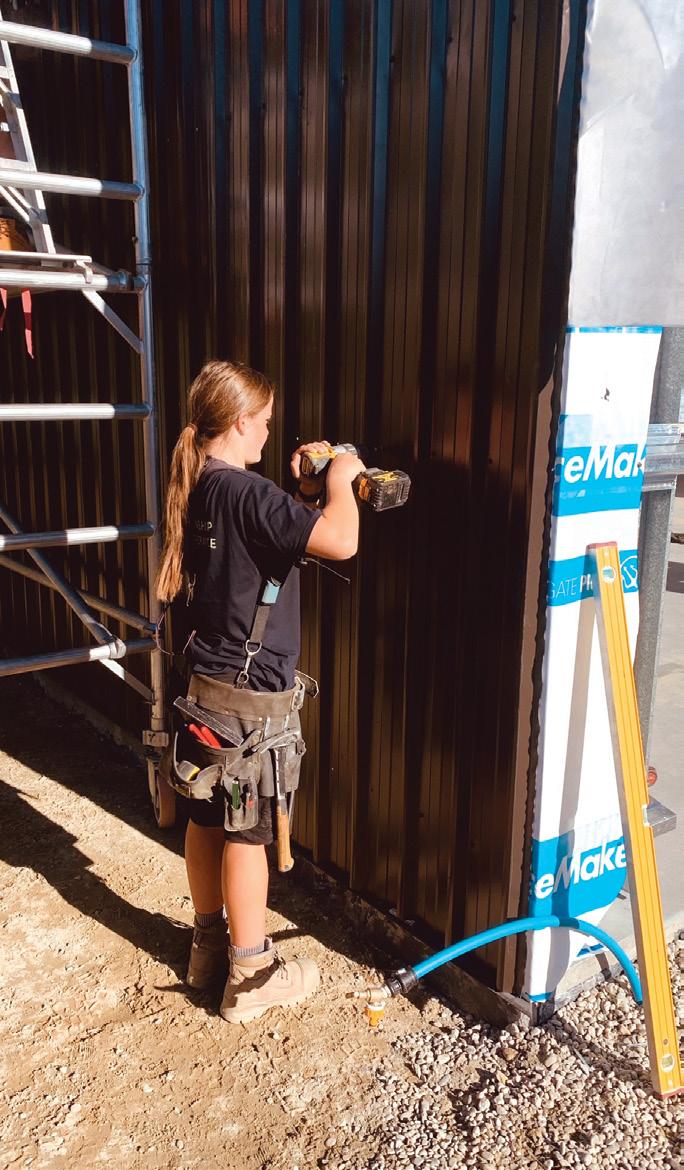

“We had six out of the 20 get their Level 2 also, 60 percent went on apprenticeships, and 40 percent came back into Level 2 school subjects. Nobody fell through the cracks. All four schools have achieved similar success and the students progressed forward.”
Work experience
In addition, with the support of the Withiel Fund Charitable Trust and its trustee Martin Scott, 20 Year 10 students at Cromwell College and Dunstan High School are also participating in work experience as part of the programme.
Hayley, 15, from Dunstan High School, says she feels so much happier at school since starting COYEP this year and gaining an understanding of the building trade with Tom Cooney Construction.
“I am glad my week is split up between school and work experience. I am happy and motivated to learn. COYEP allows me to work and come to school to gain enough credits to pass my NCEA Level 1. I really see building as my future career path,” says Hayley.
Tom Cooney has supported COYEP since its inception and wishes such a programme existed when he was at school.
He says he was not academically inclined and needed something like COYEP to help him determine his future.
“This gives the students an early idea of a career they might enjoy. I had to wait a couple of years after secondary school before I discovered building,” he says.
“I think COYEP is awesome and a good opportunity for the young people in our community. We’ve got one young man from COYEP working full-time with us now in the second year of his apprenticeship and Hayley is doing work experience on Fridays.”
Amelia, 15, from Dunstan High School, is on work experience at GWD Toyota Alexandra.
“Since starting COYEP I feel more motivated and focused to complete my schoolwork. COYEP has given me the opportunity to go out and gain work experience in an industry I see a future career path in and is setting me up well for the future,” says Amelia.
“I feel more motivated and focused to complete my schoolwork. COYEP has given me the opportunity to go out and gain work experience in an industry I see a future career path in and is setting me up well for the future.”
Amelia, 15
48 Education Gazette gazette.education.govt.nz
Top: Dunstan High School student Hayley enjoys her construction work experience.
Bottom: Dunstan High School student Amelia at GWD Toyota Alexandra.
Community focus
One of Sarah’s responsibilities is exploring a range of different pathways for learning.
“COYEP has a community focus and is an example of 21st century learning. You’ve got staff, students, and community all coming together with the support of whānau and family. We’ve got the best of both worlds and are creating connections with our community,” she says.
A long-term benefit could be that the region retains its young people, as with a localised curriculum the education is overlaid with the context of relevant trades and industries.
“For us here in Cromwell, that’s things like viticulture, horticulture, the trades, hospitality, snow sports, and agricultural industries. These can become the context for learning in English, science, maths and other subjects.
“The COYEP programme is ahead of its game and this type of learning is where education will move to everywhere in New Zealand in the future, I believe. We’ve been lucky to pilot this and we’re happy to share our learning with other schools,” says Sarah.
Feedback from employers is also crucial to how the curriculum is shaped, she says, such as the importance of being able to construct formal emails, to answer phones professionally and to measure in millimetres rather than centimetres in the trades’ world.
Student achievement, engagement and attendance rates all benefit from this programme.
“It really is the idea of having a village to raise a child. With this model it is possible for employers, whānau and schools to come together for the benefit of the learner. Having the student at the heart of the learning is key,” says Sarah.
“This sits perfectly inside the curriculum refresh document Te Mātaiaho with a focus on inclusive education and localised curriculum.”

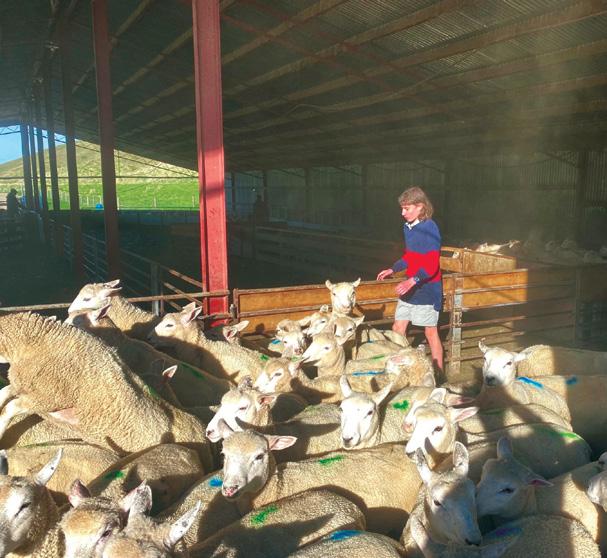

49 Tukutuku Kōrero 6 June 2023
From top to bottom: COYEP students Dallas, Lucas and Ben enjoy on-the-job training opportunities.

50
Sacred Heart Cathedral School held ‘the longest morning tea’ down their school corridors.
Bringing joy back to teaching and learning post-Covid
A whakawhanaungatanga approach between primary and secondary schools in Te Whanganui-a-Tara Wellington is tackling attendance downturns – by bringing fun times back into school again.
Ensuring students are engaged in their learning is only possible if they are physically in the classroom – this is the founding principle that has prompted Bernadette Murfitt to lead a collaboration of Wellington schools to take action against attendance downturns.
The Thorndon-based Sacred Heart Cathedral School principal applied for Ministry of Education funding to initiate a whanaungatanga approach to engaging students across several schools in the capital.
Joining with St Mary’s College, Holy Cross Miramar, St Teresa’s Karori, St Francis de Sales, and St Catherine’s College, Sacred Heart Cathedral School has begun a programme of engagement lifting strategies, with principals sharing ideas, advice and feedback through regular collaborative meetings as a principals’ group.
“The schools met every second week through Zoom to share ideas and to support each other in establishing a variety of initiatives to increase student engagement and attendance,” says Bernadette.
“The Ministry of Education put out an amazing document with some overall strategies for growing attendance. That’s where I got some of the ideas from. I thought that working together with other schools could help us all learn and grow together.
“In short, I wanted to bring fun times back into school again! It’s been a difficult few years for us all throughout the Covid pandemic and, for our staff, I wanted to bring the joy back to the job!”
Fun to the fore
Bernadette has introduced a raft of new ideas to bring the fun to fore for educators and students. Hip hop classes and whole-school sessions were popular while yoga sessions have helped students and staff engage with their selves.
“There is a real wellbeing aspect to this,” says Bernadette. “We brought nutrition into it, too. Food is a great way to get people involved, so we organised ‘the longest morning tea’, held down along corridors. Everyone contributed to this wonderful collaborative feast.”
Another large-scale effort was a whole-school wellbeing day, which Bernadette says was “great fun”.
“We also had lucky prize draws where we gave away prizes that included rugby balls and drink bottles. We did things like Scrabble, puppet-making classes and quizzes.
“We put on lunchtime workshops for parents on how they can support their child with wellbeing issues. During the term, we also provided fruit and snacks for students in classrooms, calling them ‘classroom platters’ – these were very popular,” says Bernadette.
She also shared a series of self-filmed videos on the importance of being at school, Ministry goals and research, offering support, displays and learning, protocols for absence, wellbeing, friendships and more.
Some of the simple steps the school now takes to lift attendance levels and contribute to a welcoming school culture includes staff members being at the school gates, interacting with students and their families.
“We need to get rid of the fear and anxiety and bring people together again – inside the classroom and out. Let’s find the joy in teaching and learning again!”
Bernadette Murfitt
51 Tukutuku Kōrero 6 June 2023
ATTENDANCE & ENGAGEMENT
“Staff

welcome
and greeting the students as they came into school. We also gave out gift vouchers for uniforms to try to remove barriers to attendance.”
Barriers to engagement
All the schools sought student voice to discover existing barriers to learning, and several engaged external input to support their mahi in removing these hurdles. This included bringing in mental health professionals to learn how best schools could support their families.
As well as developing its school community connections by holding a beach day, Holy Cross Miramar brought in a mental health nurse to educate parents around issues of anxiety and related behaviours.
At St Francis de Sales, a psychologist was engaged to work with those in need of mental wellbeing support. St Catherine’s College worked with a Māori elder to work supportively with some students and their families, as well as providing bus and train tickets to
students when it was found public transport costs were preventing some students from making it into school.
A picnic day was held at St Teresa’s Karori, with the school zoning in on a fun focus in its bid to maximise attendance. It also posted plenty of positive messages in its newsletters and school notice platforms.
St Mary’s set up a homework centre for students, as well as supplying uniform items and roman sandals without cost. Zumba sessions, a dance-off and dodgeball games have also been introduced to try and increase attendance appeal.
“For so long, we couldn’t bring people together because of Covid,” says Bernadette. “We had to be so careful around who could and who couldn’t come into school and how many people could gather. We had to be so aware of staying within protocols and not taking any risks of being ‘super-spreaders’.
“Now, we can do more. We can involve more people and we can bring more fun back into our schools! We know that messaging and fun times will work – this will improve attendance and engagement.”
52 Education Gazette gazette.education.govt.nz
will be outside on
duty; meeting
Students enjoy lunch together on Parliament Grounds.
Positive results
Across the six schools involved, the many different initiatives have already had an impact, although work is still ongoing.
Bernadette says, “What we have all tried to do is to make sure every day at school is filled with positive learning experiences, fun, friends, teachers, sports, games, and culture to create plenty of memorable moments.
“We know that the students who attend school regularly, learn. As well as this making them better able to pass exams and get qualifications, we believe that attendance strengthens social, cultural, and mental wellbeing. Good attendance at school is linked to having more choices.
“We also know we need the support of parents to make sure that our children are attending school and having learning opportunities. For some schools, this has meant having regular intensive communications and providing support.
“For some, this may mean meeting with whānau to build an understanding of why there might be problems. We can then look at how we can strengthen a young person’s connection with their learning and potential future pathways.”
At Sacred Heart, Bernadette is pleased to report an overall attendance rate of 88 percent for term 1 in 2023, and an improvement in punctuality.
“We need to get rid of the fear and anxiety and bring people together again – inside the classroom and out. Let’s find the joy in teaching and learning again!”


“We know that the students who attend school regularly, learn. As well as this making them better able to pass exams and get qualifications, we believe that attendance strengthens social, cultural, and mental wellbeing.”
Bernadette Murfitt
Above: Positive learning experiences are key to engagement. Below: Yoga sessions have been a key wellbeing activity.
Te Rito gets a sector-led restart
Te Rito is a web-based national information repository that enables learner and ākonga information to follow them throughout their education. A staged rollout of Te Rito will soon restart, led by the education sector.

Te Rito has the potential to connect learner information from early learning through schooling and beyond.
LEARNER DATA
The design and delivery of Te Rito is led by two sector working groups, Ngā Rau Whakatupu Māori and Auraki, in partnership with the Ministry of Education. All are confident they can now safely and securely restart a staged rollout of Te Rito.
There is strong sector support for Te Rito. The working groups and Ministry know that the more educators understand ākonga and learners, the better they can shape the support provided to them, valuing and respecting the things that make them unique.
Central to the design of Te Rito is the need to keep ākonga and learner information safe and secure and ensure ākonga and learner information is only used as intended.
The information in Te Rito belongs to ākonga and learners. The Ministry does not have access to ākonga, learner, kura or school information held in Te Rito.
How Te Rito will help educators
Te Rito will give educators more information and free up time to focus on what matters – understanding the strengths, aspirations and needs of ākonga and learners and helping them succeed.
When Te Rito is fully implemented, it has potential to connect ākonga and learner information from early learning to secondary and beyond. Right now, the focus is on the schooling sector, beginning in 2023 with a small number of schools and kura.
Consistent, accessible ākonga and learner information will enable:
» informed decision-making
» better support for ākonga and learners in your care
» purposeful collaboration with families and whānau, kāhui ako and other educators in your network.
Michael Malins of Te Rau Whakatupu Auraki says Te Rito will support students’ academic and emotional development and improve practices by deepening trust in whānau relationships.
“When we know our learners and their whānau connections, we feel more connected to our students and have a better understanding of who they are and how to meet their needs.”
Te ao Māori approach
The Ministry is committed to working with Māori and iwi in a way that honours Te Tiriti o Waitangi and reflects Te Tiriti partnership.
Myles Ferris, Ngā Rau Whakatupu Māori Chair explains that Te Rito is designed with te ao Māori principles in mind.
“From the beginning of this mahi, Māori sector leaders have been involved in the co-design and decision-making, as well as helping lead the delivery of Te Rito to schools across the motu.
“Throughout this process we have been committed to putting our tamariki and their whānau first.”
Te Rito Kaitiakitanga
Te Rito meets the requirements of the Privacy Act 2020.
In addition to these measures, in 2023 Te Rito
Kaitiakitanga will be established, which is an independent, cross-sector data stewardship group whose role will be to provide trusted, transparent and equitable oversight of data held in Te Rito.
Te Rito Kaitiakitanga will determine who can access, use and share learner and ākonga data, for what purpose and under what conditions.
Planning for 2023–24
The relaunch of Te Rito will focus on the schooling sector, starting with a small number of kura and schools in 2023, and expanding as we learn how Te Rito can best support educators, learners and ākonga, and their families and whānau.
The standardised Learning Support Register (sLSR) is not part of the restart.
Any feedback or questions on Te Rito can be sent to terito@education.govt.nz.
About Te Rito
Te Rito will enable learner and ākonga information to follow them throughout their education and has a wide range of other functions to support teaching, learning and administration.
The programme is guided by a whakatauākī gifted to the programme by members of Te Rau Whakatupu Māori (the Māori-medium sector working group).
Me tiaki te mana o te tamaiti me tōna whānau
Protect and uphold the mana of the child and their whānau
The name Te Rito represents the baby flax at the heart of the harakeke.
Te Rito has the tamaiti and child, and their whānau and family, at its heart. They are at the centre of everything we do. The name, which comes from the whakatauākī “Hutia te rito o te hakakēkē” was gifted by Te Aupouri whose ancestor, Meri Ngaroto, is credited with the whakatauākī.
55 Tukutuku Kōrero 6 June 2023

Gold Star helps you prioritise your mental health
Get on board with Gold Star and join like-minded colleagues who are learning more about mental health, to help in your everyday life.
The Ministry of Education and EAP Services are behind Gold Star, a wellbeing programme designed specifically with early childhood, school and kura workers in mind.
Visit Gold Star online to find our webinars and eLearning modules that are made especially for you, to help better understand mental health, and how we can improve our wellbeing.
Remember, you always have access to counselling through EAP Services. Talking with one of our fully registered counsellors can make a world of difference. You can make an appointment here: bit.ly/3IQhYlu
Find us at www.goldstar.nz
Sign up for Gold Star for free and discover the benefits:
• Help you feel less stressed at work
• Build resilience in times of change
• Guide your personal development or career direction
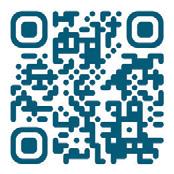
• Give you tools to handle conflict or tension in the workplace
• Offer resources to support you with lifestyle or health issues

Sign up for free
Scan the QR Code to sign up and start your first module.
www.goldstar.nz
© 2022 EAP Services Ltd – Partnering for Performance – The Ministry of Education
To view the PLD, general notice listings and vacancies at gazette.education.govt.nz


Applications and referees’ reports are due by 4pm, Thursday 22 June 2023 For an application pack or confidential inquiries, contact Stuart Myers, smyersmbl@gmail.com
Cook Islands Early Learning Service - Tokoroa
We are seeking a passionate and enthusiastic Registered ELS Teacher in a fulltime position, at the earliest convenience, who can work alongside our dynamic team and community that will nurture our TAMARIKI with growth and potential at Te Ara Metua Punanga Reo Kuki Airani Inc., Tokoroa.
We have:
• Strong Cook Islands Maori Philosophy and Environment.
• Extended Pay Parity as per table scale.
If you are interested in applying for the position, please submit your resume, with cover letter, and direct enquiries to: Ani Maea P O Box 117 TOKOROA 3444
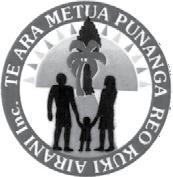
Tumuaki/Principal U4
Hikurangi School (Roll 198) is a Northland full primary school catering for students from years 1 to 8. 78% of the student population identify as Māori and the tamariki learn in a beautiful setting in the town of Hikurangi. Hikurangi School originally opened in 1883, with the current school site being built in 1920. At our school we strive to provide our tamariki with many and various opportunities to experience and learn from. Our tamariki are encouraged to display the qualities of whakapono truth and honesty, manaakitanga hospitality, caring and kindness, tūmanako hope and aspiration and te aroha tanga love, affection and charity in different situations throughout their time at the kura. Our schoolwide statement that we use to promote these four Uara is kia pono ano kia koe (always be true to yourself).
Staff at Hikurangi School are conscious of growing lifelong learners through opportunities to wonder, explore, connect, laugh, play and perform. These wonderful life skills will prepare the tamariki in all age groups to be 21st century leaders.
The supportive and forward-looking Board seeks a motivational, collaborative and inspirational leader who positively embraces modern teaching practices. This is a wonderful opportunity to lead the school and its community through the next stage of development.

CHEVIOT AREA SCHOOL SEEKS A DYNAMIC PRINCIPAL
This picturesque school, set in the rolling hills of North Canterbury, has a roll of 195 across Years 1 - 13. It is a school with a heart, a school steeped in a rich 130-year history. It is a school with so much potential.
We seek a Principal who is committed to teaching and learning, thinks outside the box, is motivational, a strong communicator, and plays to the strengths of the team. We look forward to welcoming a new Principal who is passionate about our school and students, who wants to be a part of our community, and lives and breathes our values.
He aha te mea nui o te ao? He tangata he tangata he tangata!
What is the most important thing in the world? It is people it is people it is people!
To learn more about our school and apply for this position, please visit: www.cheviot.school.nz
Applications close on Wednesday the 5th of July at 5pm
FLAG 57 Tukutuku Kōrero XX Xxxxxx 2023 VACANCIES
Principal Vacancy
PLD
Scan the QR codes with the camera on your device. VACANCIES NOTICES
With so much going on in life right now, gift tamariki the skills to be present.
Pause Breathe Smile is a mind health programme that includes development of students’ inner skills. The programme cultivates self-awareness, attention control and emotional regulation. This allows students to manage themselves better by choosing their behaviours based on mindful attentiveness rather than impulse reactivity.
Southern Cross’ support makes it possible for Pause Breathe Smile PLD is FREE for any NZ primary or intermediate school. Curriculum-aligned with resources in both English and Māori.
Find out how.
Email coordinator@pausebreathesmile.nz
pausebreathesmile.nz
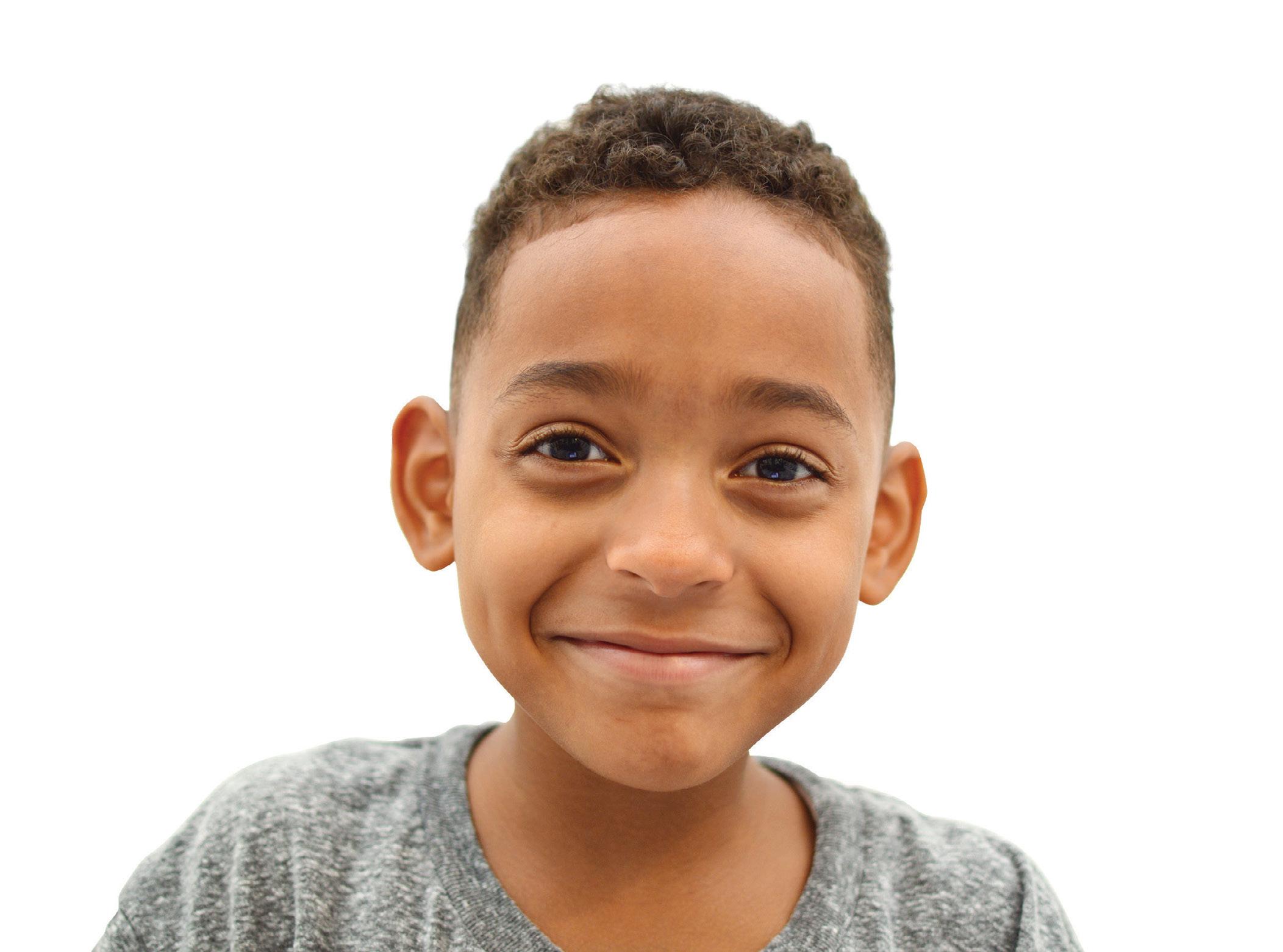
Delivered under licence from















 Above: Brenda Tomkinson. Below: Amanda Bailey.
Above: Brenda Tomkinson. Below: Amanda Bailey.













 Doug says the experiences and conversations that happen outside the classroom are “absolute gold”.
Doug creates hands-on, fun and engaging activities for students at St Patrick’s College.
Doug says the experiences and conversations that happen outside the classroom are “absolute gold”.
Doug creates hands-on, fun and engaging activities for students at St Patrick’s College.







 The Whanganui River runs through Central King Country.
The Whanganui River runs through Central King Country.











 Empowering a generation of ‘Girl Bosses’ in healthcare, science and sport PATHWAYS
Empowering a generation of ‘Girl Bosses’ in healthcare, science and sport PATHWAYS

 Alexia Hilbertidou.
Alexia Hilbertidou.
















 Central Otago Youth Employment Programme manager Jenna Faulkner and Cromwell College assistant principal Sarah Hill.
Central Otago Youth Employment Programme manager Jenna Faulkner and Cromwell College assistant principal Sarah Hill.

















